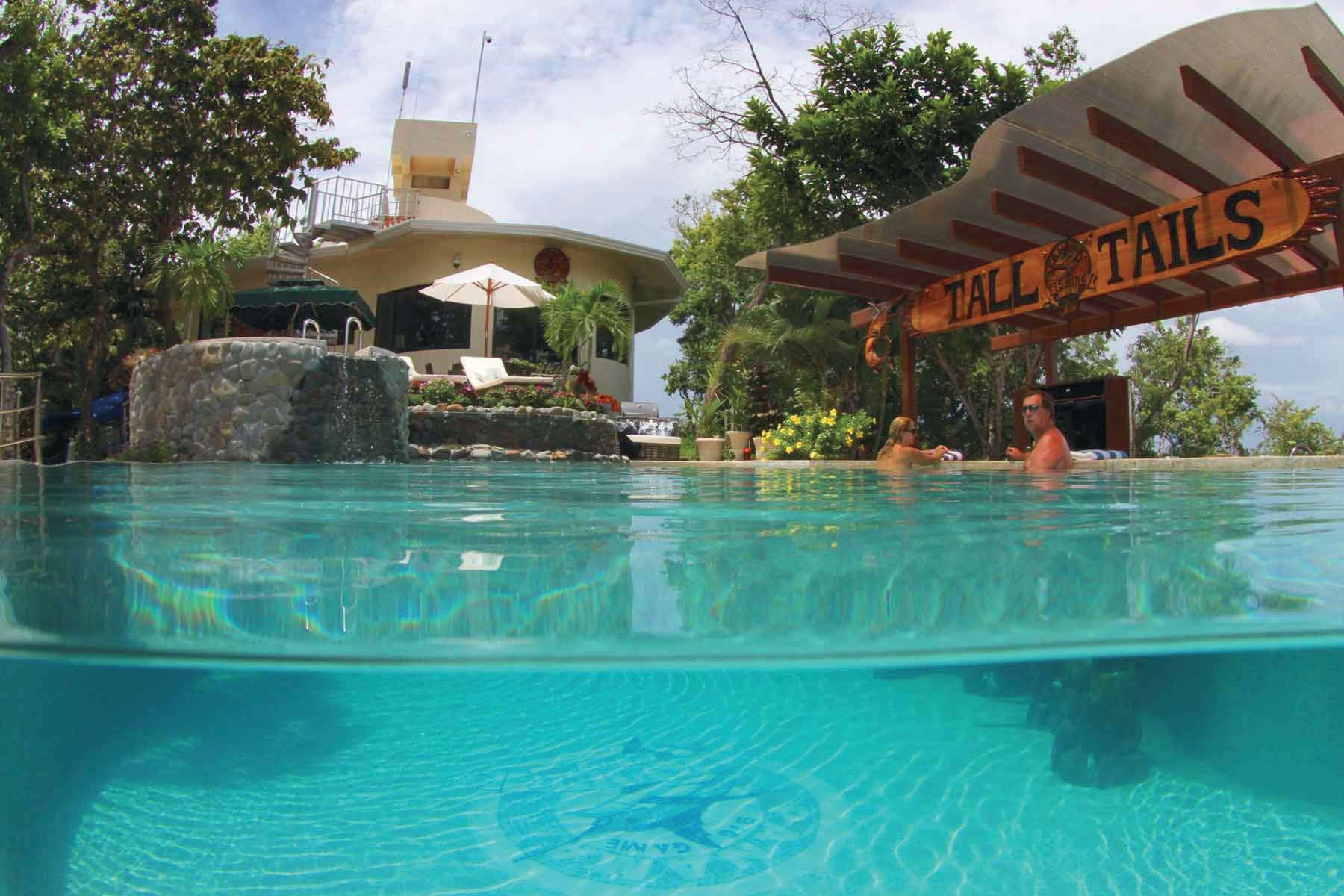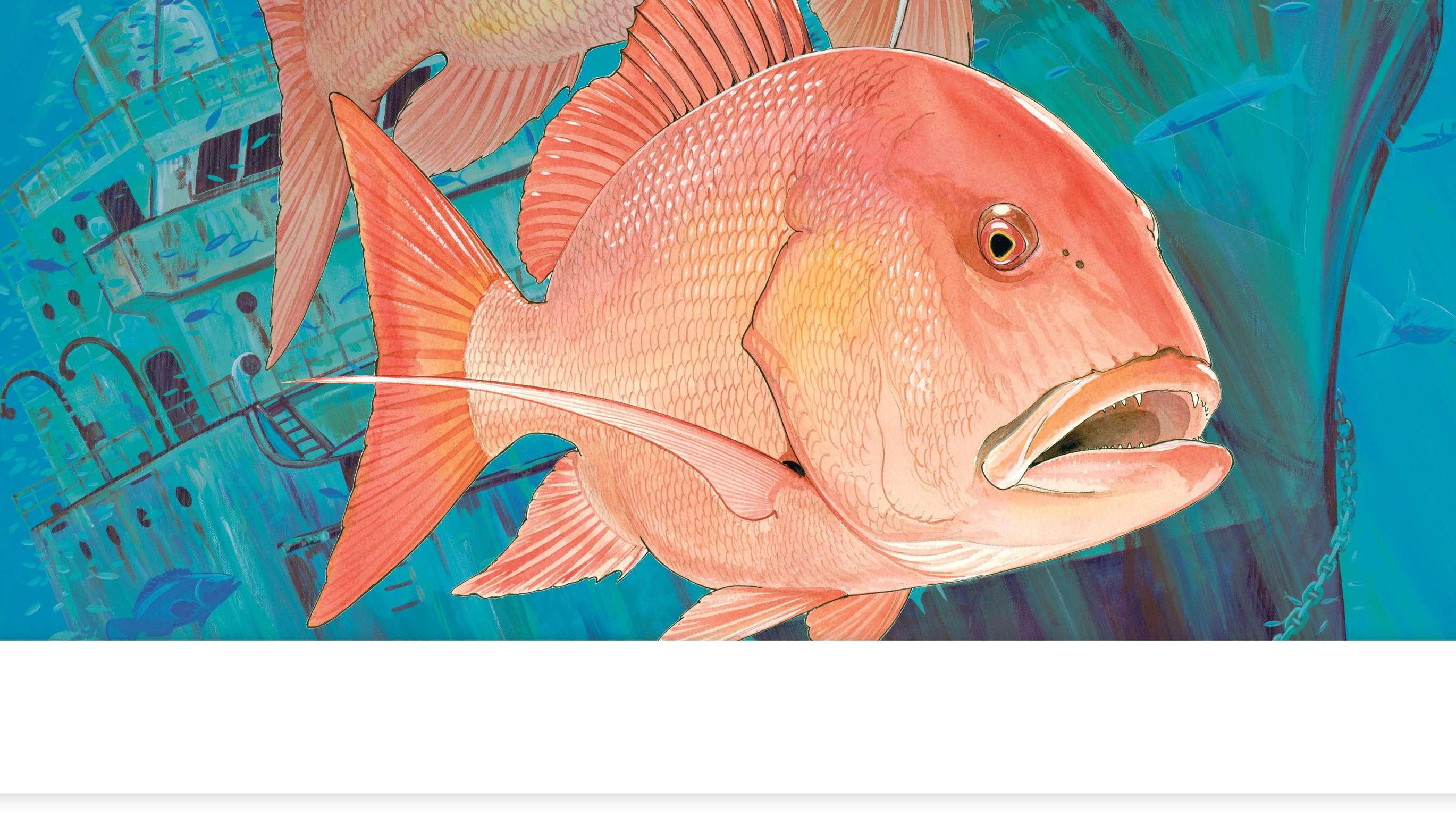
37 minute read
Jon Hauge

A speckled trout is caught at the Zundel’s Reef in Point Clear, Alabama. Zundel’s Reef is part of the artifcial reef program established by the Alabama Department of Conservation. The trout apparently survived an attack, as a good portion of its back near the dorsal fn is missing. Right: A foggy December morning as fshermen try their luck on the Apalachee River in the Mobile Delta.

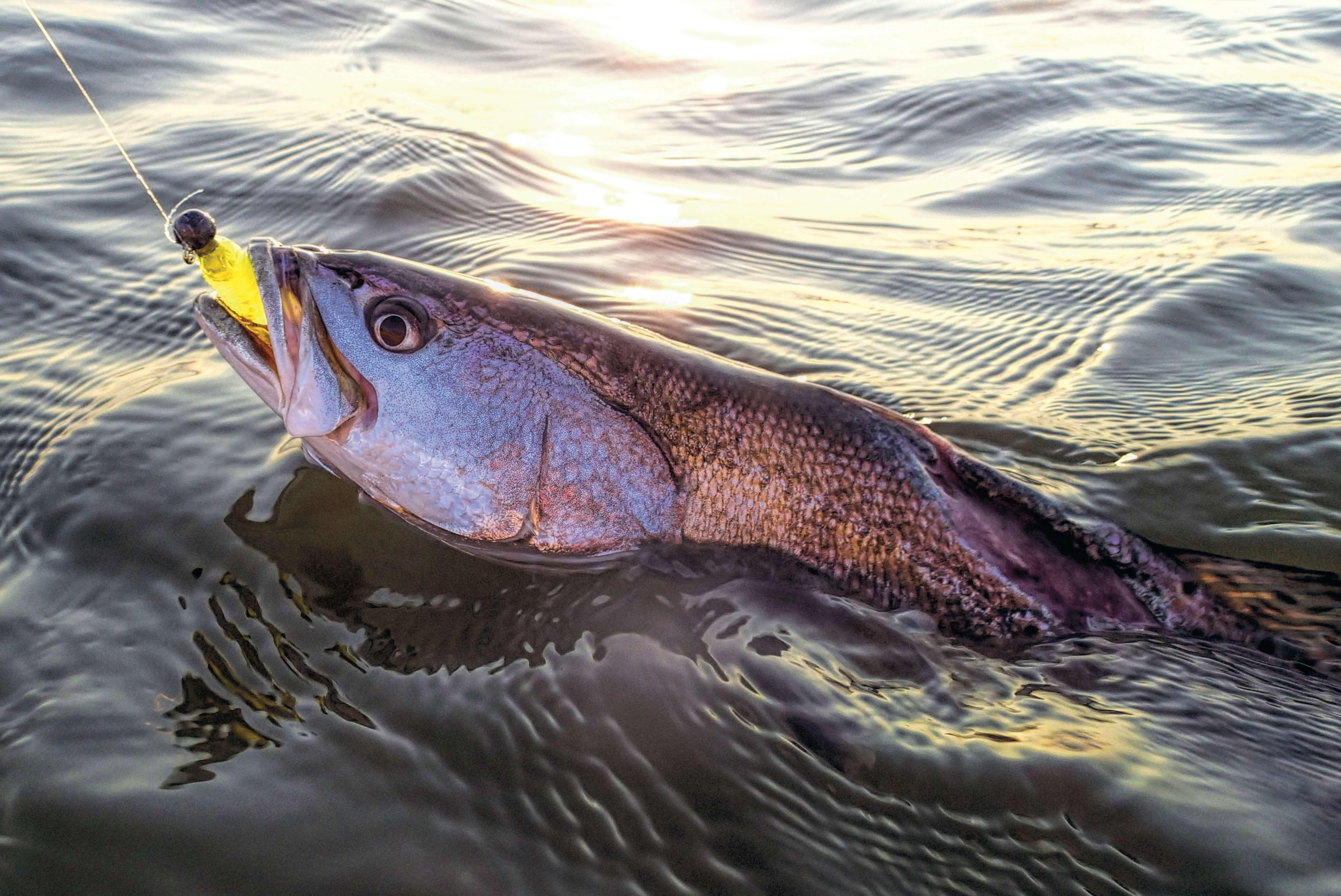

a photo portfolio
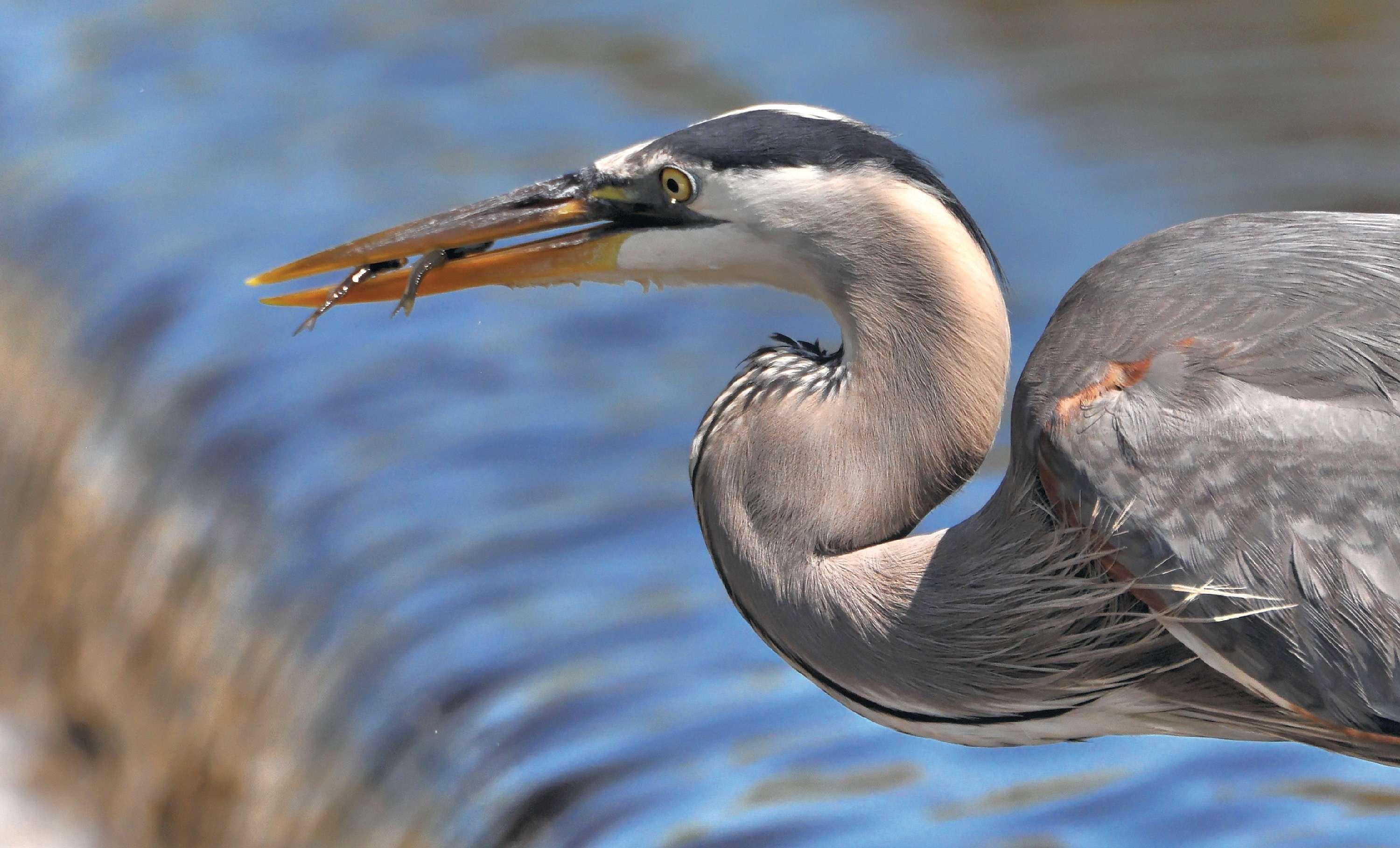
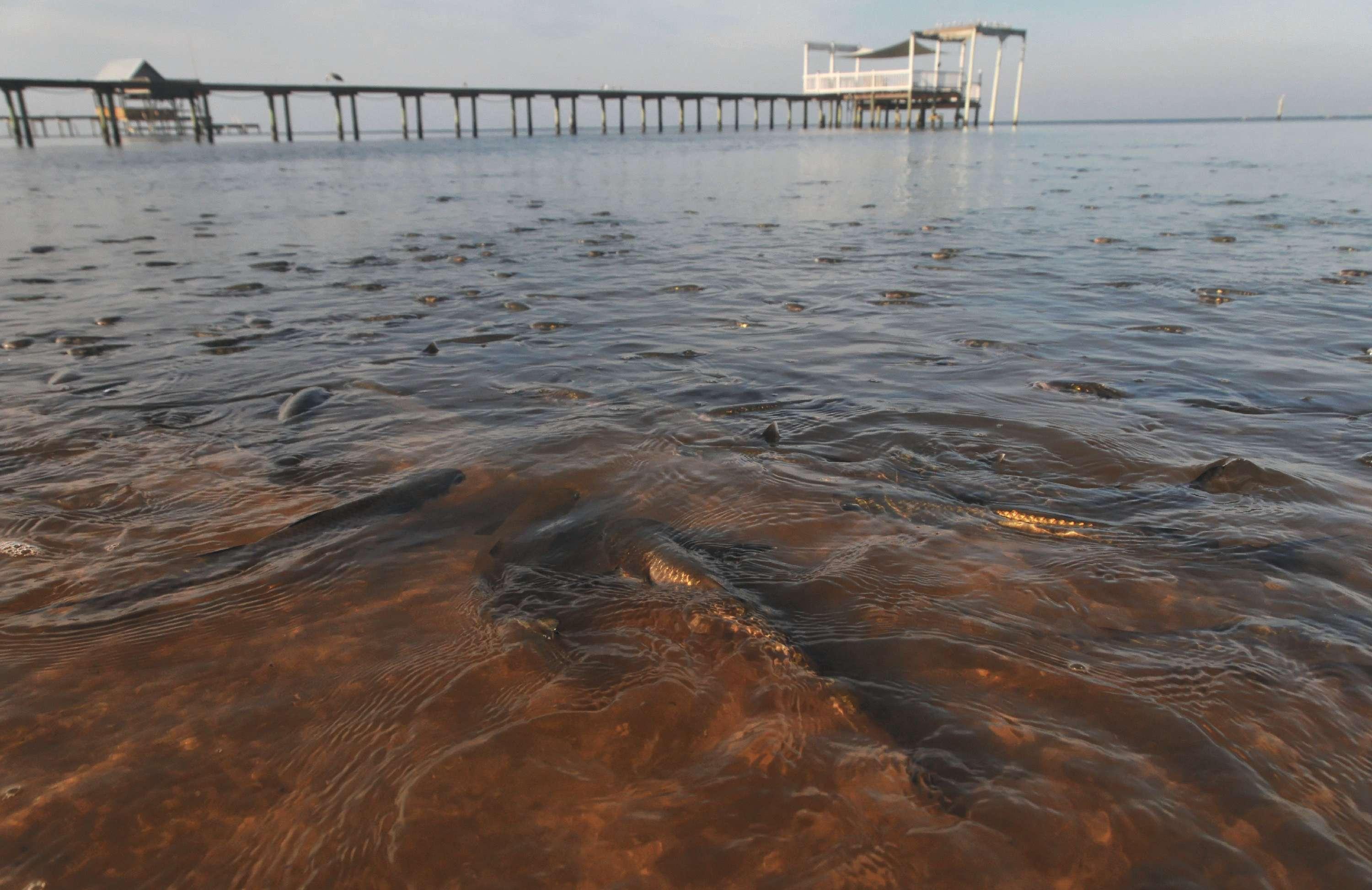
Above: A young boy throws a castnet at the Fairhope Municipal Pier. Opposite top: A great blue heron catches fsh in a bayou at the Gulf State Park in Gulf Shores, Alabama. Opposite bottom: Mullet school in shallow water during a jubilee in Point Clear, Alabama.

Tarpon, Islamorada. Opposite: Sunset view from Bud N Mary’s Marina, Islamorada. A boat leaves the mouth of Weeks Bay and heads out to Mobile Bay on an April evening. Top right: A speckeld trout caught near Mullet Point in Mobile Bay. Bottom right: A redfsh fashes the eye spot on its tail as it puts up a fght after getting caught in Fish River. (Fish River leads into Weeks Bay and eventually to Mobile Bay.)
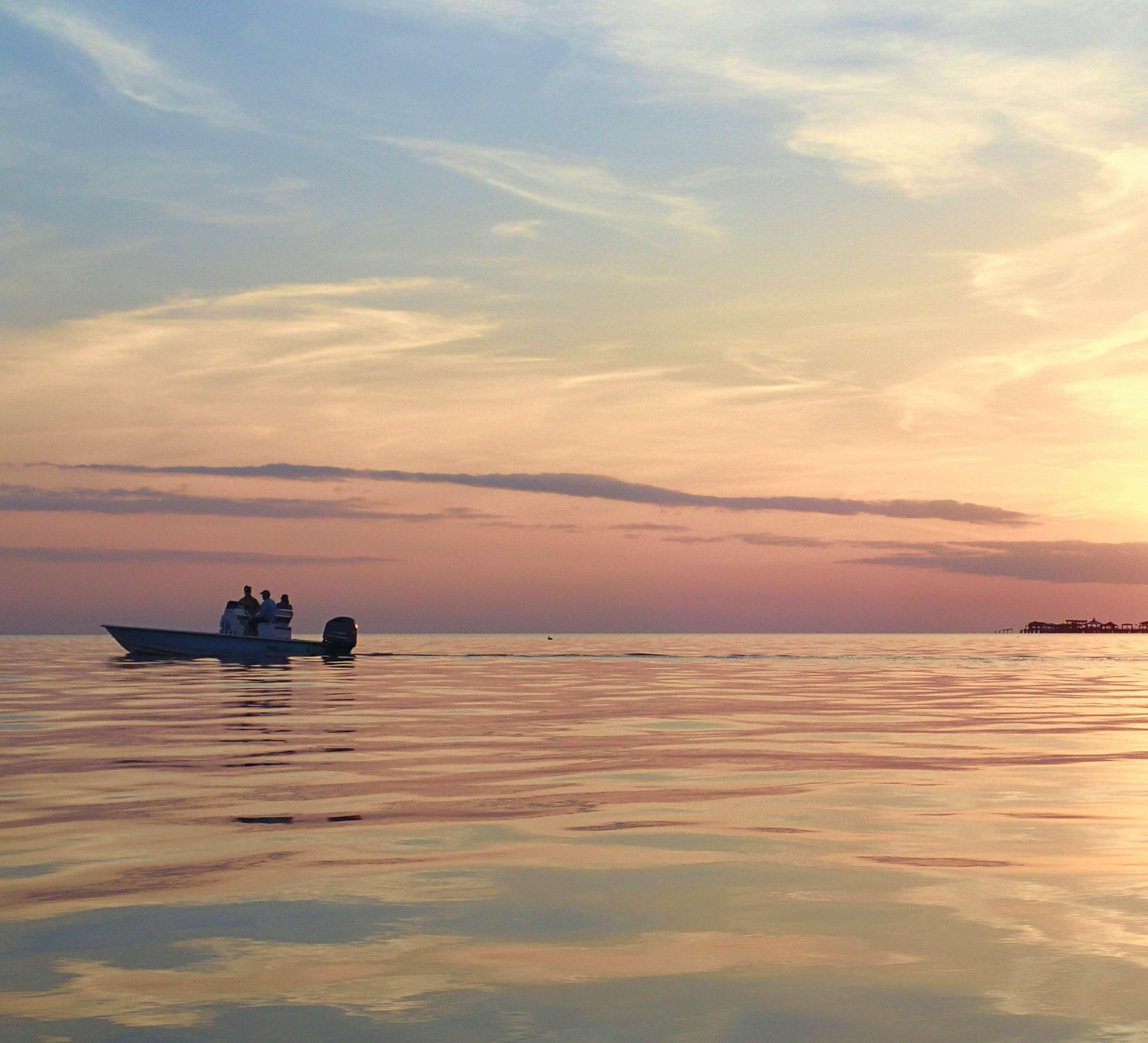

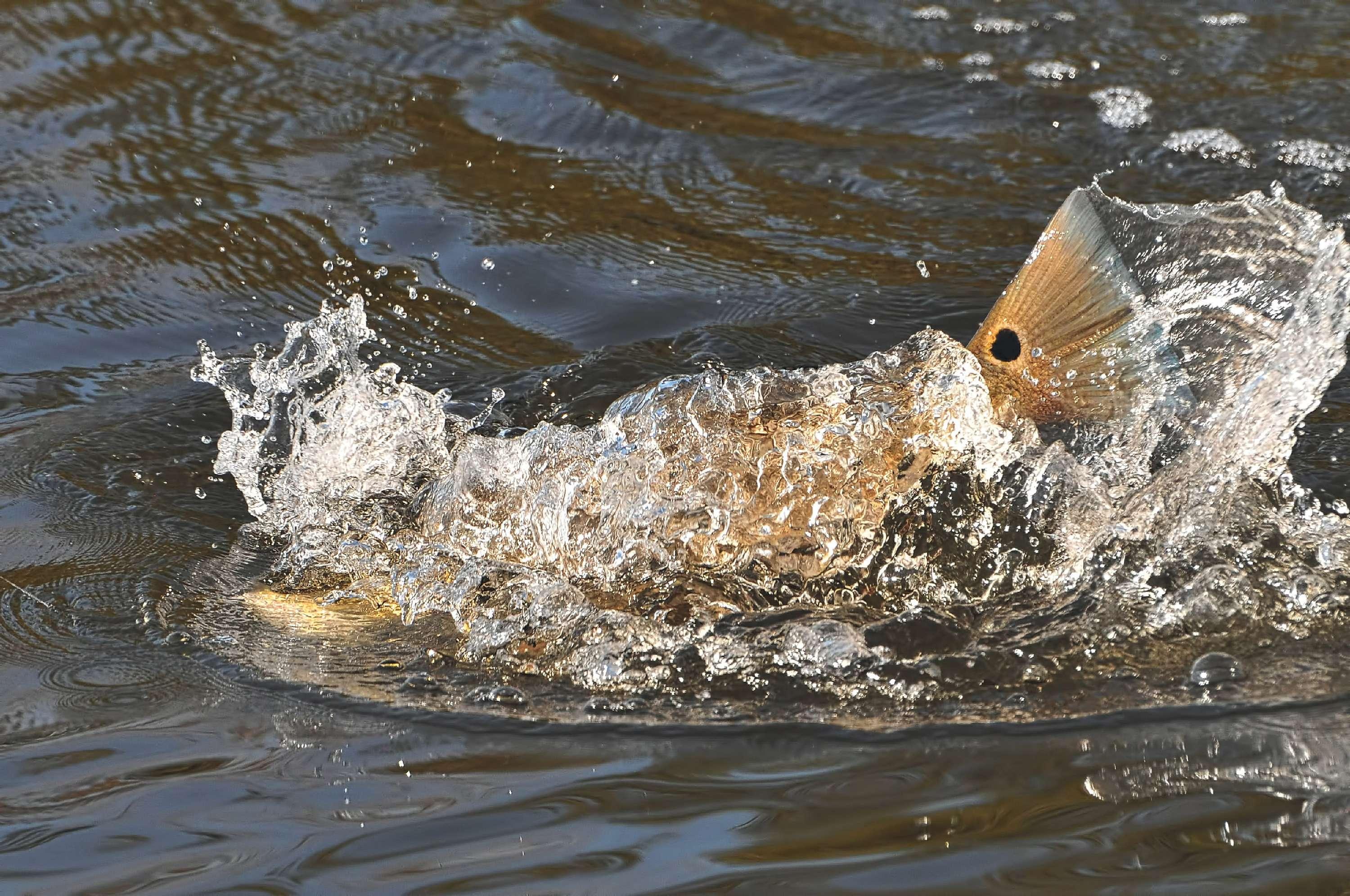
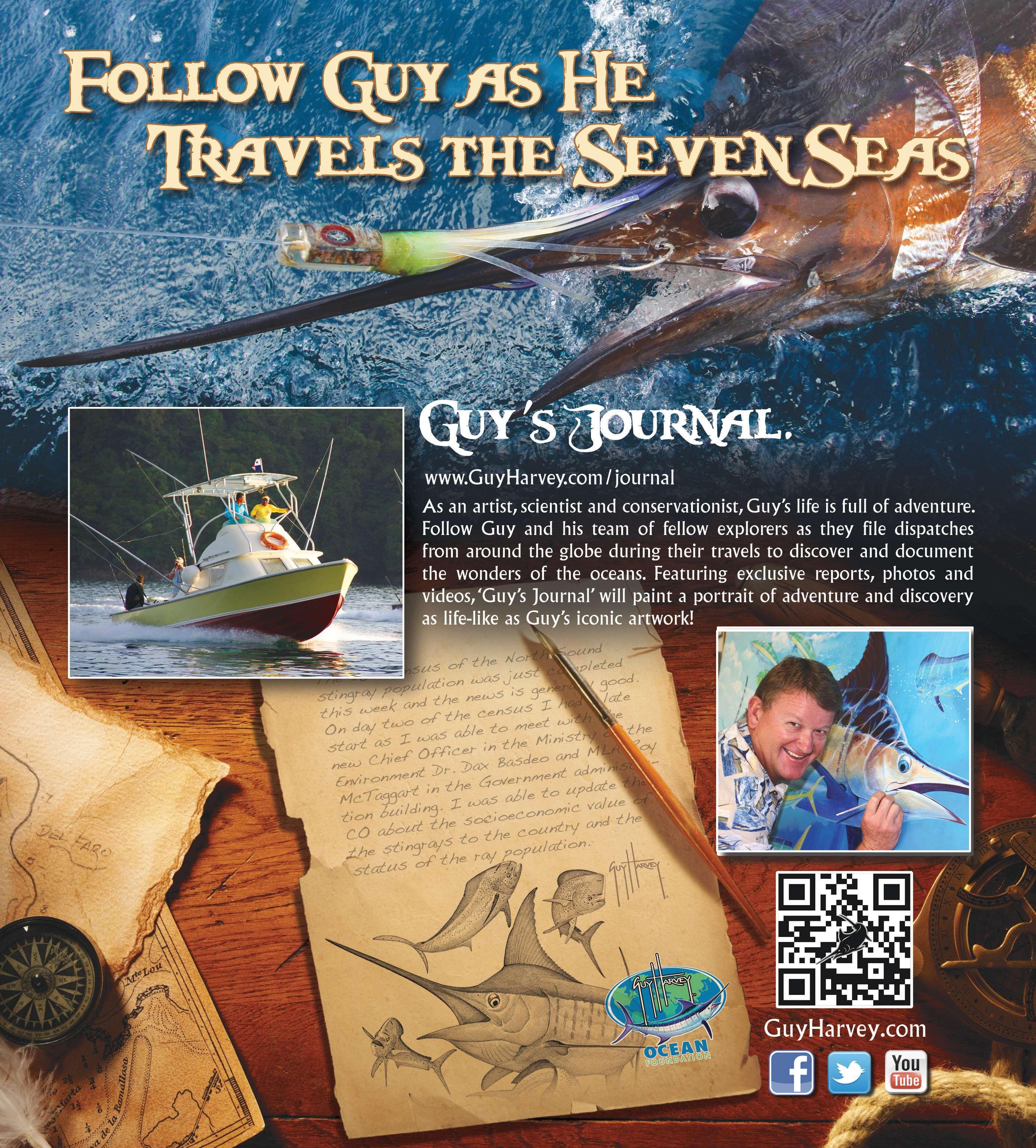
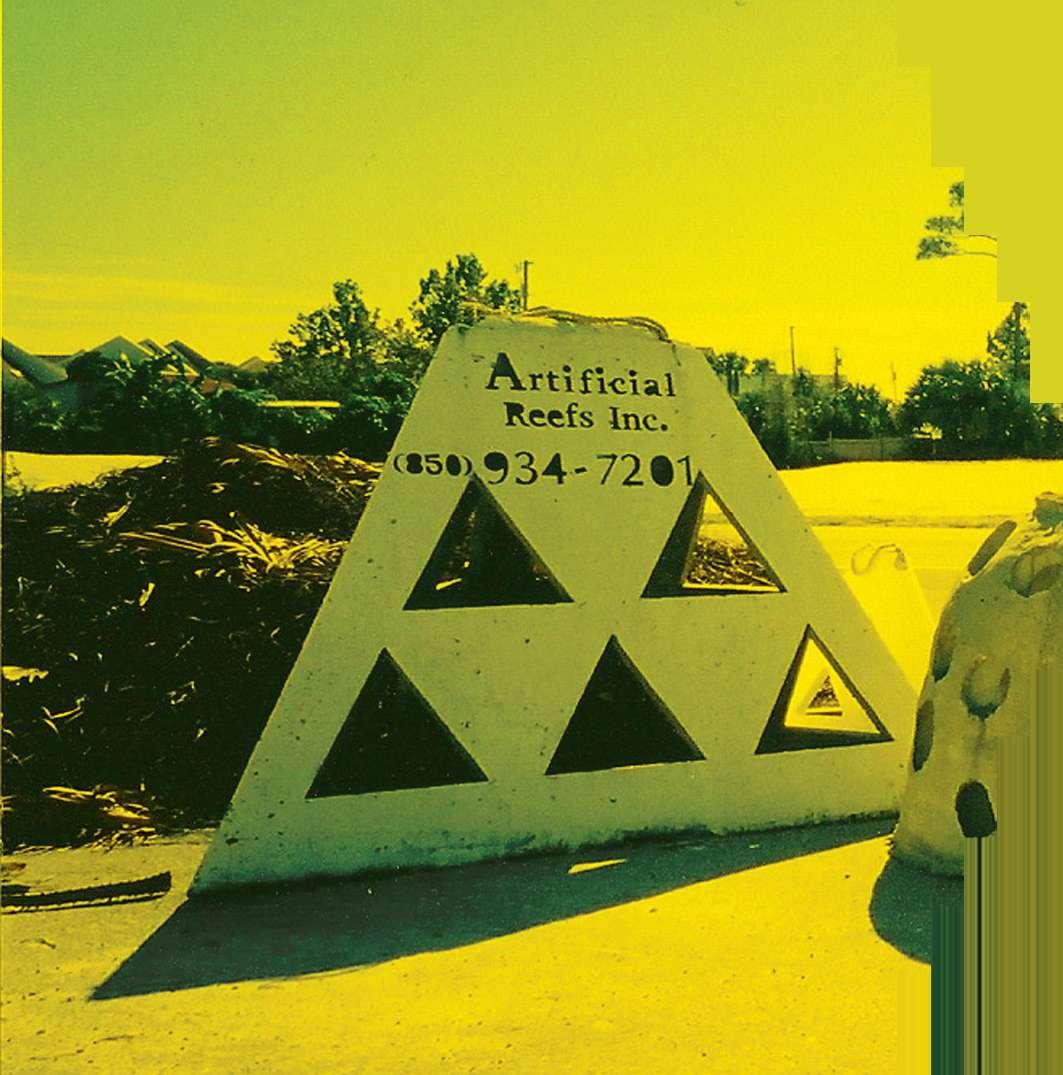
BY EDITOR
NICK HONACHEFSKY
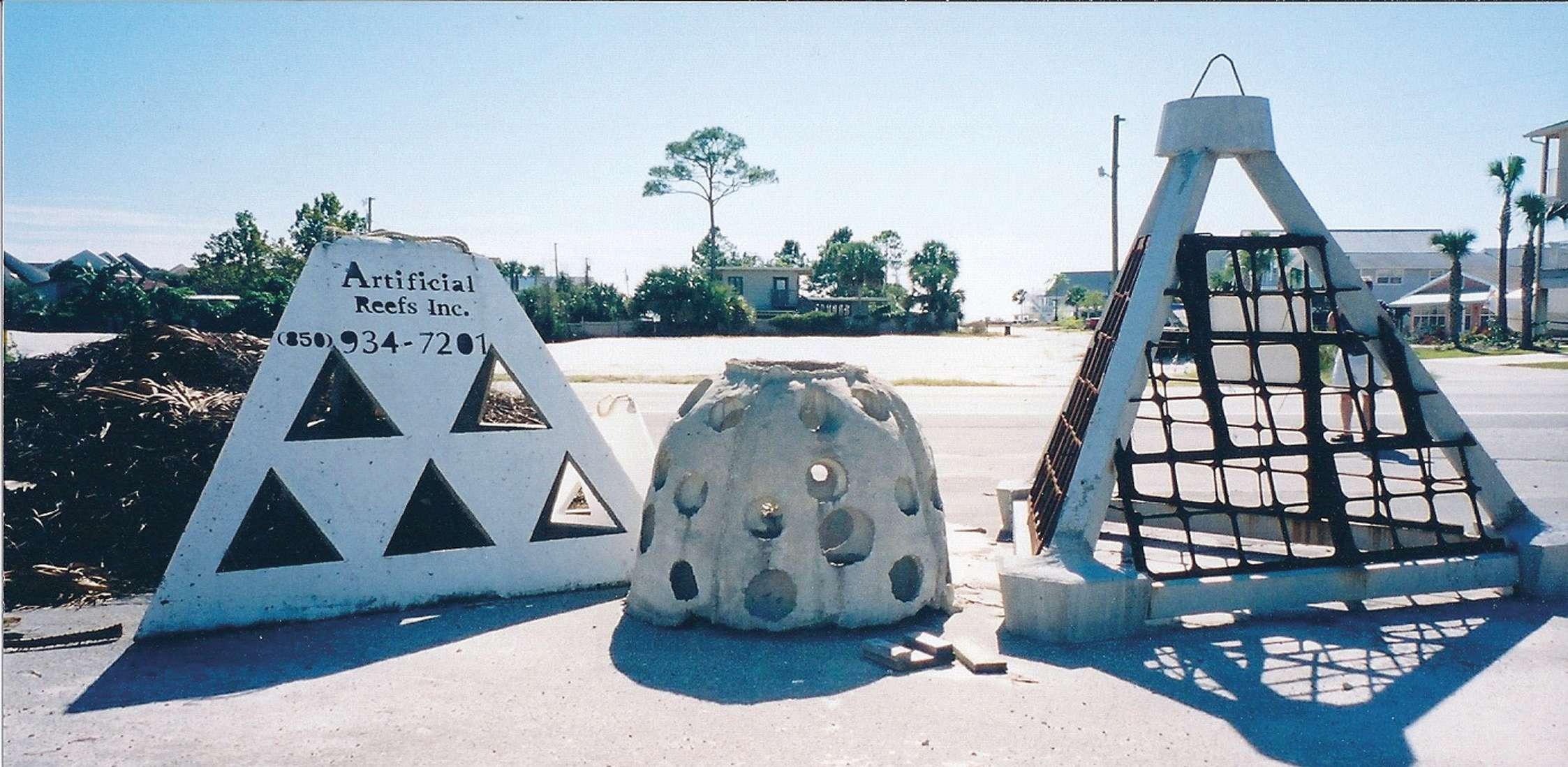
Artifcial Intelligence
Choosing the right structure for man-made reefs.
“Build it and they will come.” We can thank Kevin Costner’s fick Field of Dreams for populating that bit of pop culture wisdom, yet it’s a sentiment that rings true in many circumstances. Maybe not for actually attracting the spirits of baseball legends past to a cornfeld, but it does work with fsh. If you build habitat in a watery wasteland, like the expansive, sandy bottom of the Gulf of Mexico, it will attract fsh almost instantly.
Artifcial reef programs have sprung up in coastal states all across the nation and have fostered incredible benefts, both for recreational and commercial fshing opportunities. Studies have shown that habitat creation can lead to an actual increase in fsh stocks, but there has been a learning curve when it comes to creating efective and durable reefs. As early as the 1960s, states such as Alabama began deploying old automobiles. The car bodies attracted fsh, but also proved quick to break up and were easily pushed around by storms. Some cars and other smaller items also began to show up in commercial trawling gear—not good. It soon became obvious that bigger and heavier were better. By the 1970s, a major push to sink mothballed ship hulls got underway. Again, Alabama was one of the early recipients and began deploying Liberty ships—derelict cargo vessels from WWII. With an expected lifespan of 50–80 years, these and other vessels are still providing productive habitat for anglers all along the Gulf Coast.
Today, the process of reef deployment is governed at both the federal and state levels. NOAA’s National Artifcial Reef Program requires that structures be evaluated by four criteria: Function—the overall design of a structure in relation to promoting marine growth; Stability—the underwater movement of structure; Durability—resistance to deterioration and breakup; and Compatibility— maximizing fshing benefts. Reefs can be constructed and formed from raw building materials, like concrete reef balls, or large objects can still be deployed. Over the years, the latter have come in all shapes and sizes, including army tanks, subway cars, airplanes, tanker ships and rubble from demolished bridges.
The upside to large vessels, like ships or subway cars, is size and, usually, durability. But cleaning these vessels before they go in the water has also become a highly regulated process. At frst blush, it may sound simple to strip an old ship hull and prep it for sinking, but there are all kinds of materials to deal with: oils, fuel, lead-based paints, asbestos insulation and the list goes on. Some years ago, a group of Redbird subway cars was deployed of New Jersey and Delaware. Detractors of the project cited the supposed environmental concerns of small levels of asbestos in the glue used to secure the foor panels and in the insulation material in the walls, but it was determined to be nonfriable asbestos bound in epoxy, and not a signifcant environmental threat. So, the Redbirds went down, but they still didn’t work out as well as hoped. The subway cars were expected to have a life expectancy of 25 to 30 years, but the sidewalls and roofs were collapsing within 10 years—not due to the corrosion of the stainless steel material, but from a combination of wave fexing and the method and materials used to connect the walls together in the frst place. It was a live-and-learn experience.
Fortunately, the art and science of reef creation has made real progress. In 2004, the Gulf States Marine Fisheries Commission published Guidelines for Marine
Artifcial Reef Materials, which efectively details the pros and cons of certain structures to be used in artifcial reefs. Other coastal states, like New Jersey, have done the same. We’ve come a long way from the “old days” of deploying concreteflled automobile or truck tires bound together with wire. Tire units provided great habitat for fsh and lobsters to hide, but the rubber tires outlasted the wire used to bind them together, and old tires soon started showing up in places they never should…sometimes hundreds of miles away! The bottom line is artifcial reefs make great fshing habitat, but whether a public project or putting down a “private” structure, it pays to be smart about what is deployed. Following is a list of popular reef materials and their pros and cons.
Bridge rubble — Acceptable demolition debris includes concrete, brick, stone, glass and heavy gauge steel. Unacceptable are materials of low density that can be swept away, such as corrugated sheet metal, aluminum and plaster. Debris must be free of foatables: wood, plastic and containers. The bigger the pieces, the better.
Subway cars — Roof or sidewalls with no support or inferior connectors collapse, but the spacious windows and doors provide myriad openings for fsh to swim freely.
Ships — Steel-hulled vessels are durable with a 50- to 80-year life span, providing a virtual condominium for fsh. They resist most hurricane surges, however, Hurricane Andrew scattered many large, steel ships 300 to 2,300 feet away from their original place of deployment. Wooden- and fberglass-hulled vessels are not dense enough to stay in place on the sea foor and are quickly torn apart and scattered by storms.
Oil platforms — Stable enough to withstand storm surges and provide marine growth up the entire water column, platforms just need to be cleared to an appropriate depth for safe navigation of vessels.
Tanks and military vehicles — Within four to fve years,
thick vegetation mats grow on the metal, colonizing up to 5,000 mussels in a square foot. Heavy-duty hardware stands up to storm surges, and some units have nearly a 100-year life span. The downside is there are fewer portholes or cavities for fsh to move in and out.
Reef balls — Hard substrate perfect for life to cling to, these concrete structures can be designed for specifc applications or sites, and they are easy to deploy.
Automobiles — Car bodies have a short life span (up to 5 years), are laborious to clean and are easily moved by storms.
Appliances, aka “white goods” — Usually no good, as the
surface material is slippery and harder for marine growth to cling to and items are easily moved around by storm surges.


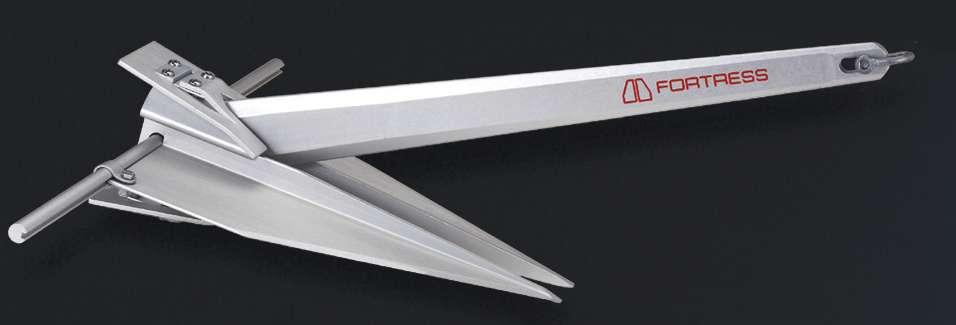




Big Fish
Chris Blankenship
BY CA STAFF
In 2011, Chris Blankenship was appointed director of the Alabama Marine Resources Division of the Alabama Department of Conservation and Natural Resources. That’s a heck of a title to squeeze onto a business card, but it means Chris is in the middle of all things seafood. More specifcally, it entails balancing a number of different goals, some of which might seem to confict with each other. Chris is tasked with promoting the sustainability of Alabama’s fshery. That means being part of the state and federal process of writing and enforcing fshing regulations. A native Alabamian and avid fsherman, he’s also passionate about expanding fshing opportunities—like increasing red snapper limits. And, he’s been tasked by the governor to help promote Alabama seafood, maximizing the economic impact of recreational and commercial fshing in the state.
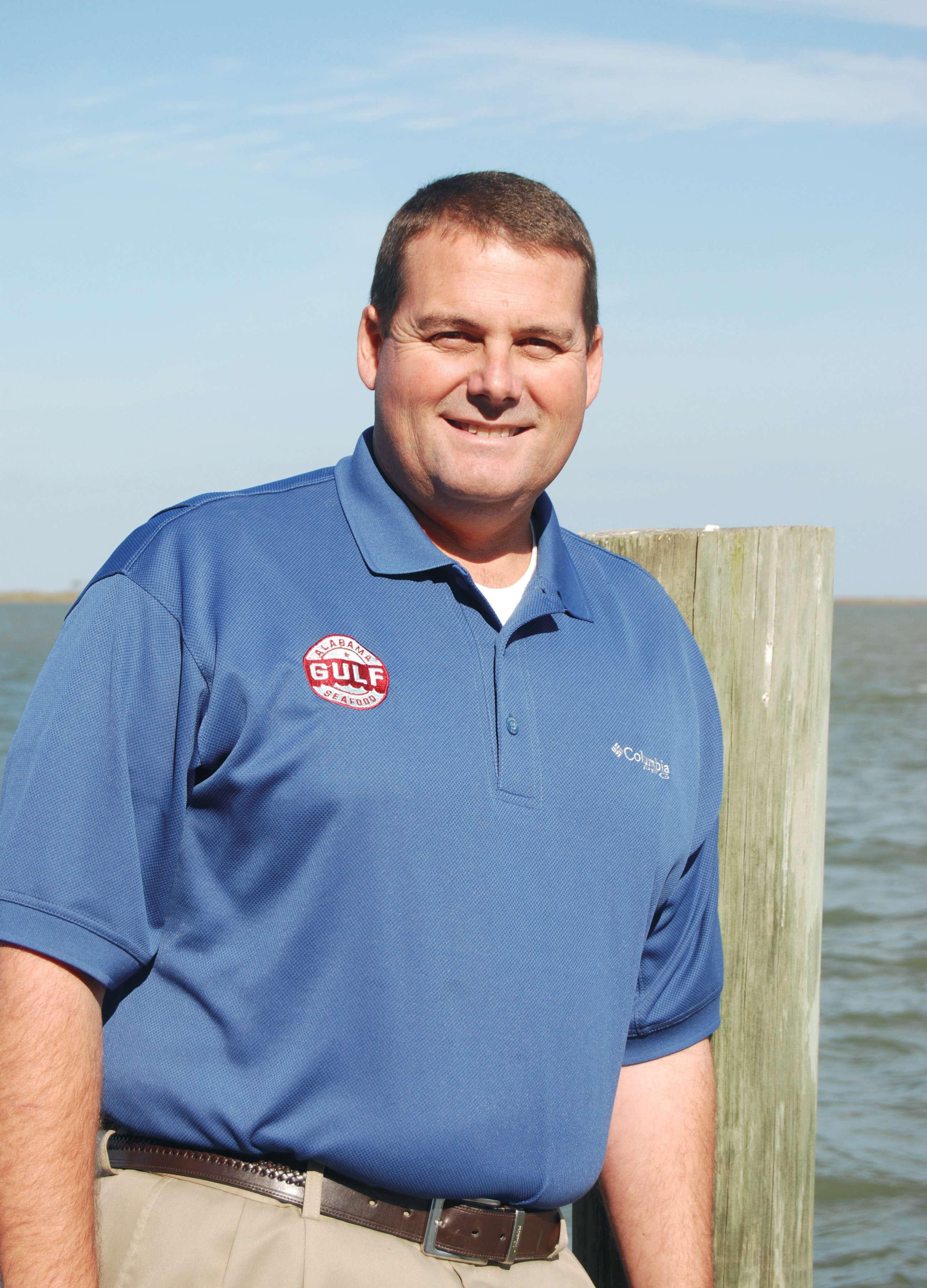
CA: Chris, with all of this,
do you still get to go fshing for fun? What’s your favorite species and tackle for a day on the water?
CB: I love to sh, but I do not get to go as much as I would like. I stay pretty busy working to manage and promote the sheries in Alabama, but over the last year, I have made myself set aside time to sh with my family. When I do get to go, I love to catch mackerel. I like trolling for Spanish mackerel with my kids. The sh are easy for my youngest daughter to reel in and there is usually plenty of action with Spanish, lady sh and blue runners along the coastal beaches. My absolute favorite is shing around the gas platforms for big king mackerel. I love to hear the drag zing out on the Diawa spinning reels my dad gave me. The big kings in Alabama are plentiful all summer and make for some really exciting and tiring shing trips. Last Fourth of July weekend, my son and I caught and released over 70 kings at a rig within ve miles of Dauphin Island. I nally had to take all the lines out of the water so we could eat and drink some PowerAde before we passed out. It was non-stop action. It does not get much better than that! The red snapper shing o Alabama is also so great that it has been easy to get a limit when the shery is open. I try to go shing as often as I can during snapper season.
CA: Alabama has a relatively
small slice of the Gulf ’s coastline but a very prolifc fshery. What makes the state’s coastal waters unique?
CB: The Mobile Bay watershed is the sixth largest in the nation by area and at 62,000-cubic-feet-persecond, it has the fourth largest freshwater infow on the North American continent. The Mobile River Delta is also the second largest river delta in the country. All those nutrient-rich waters mixing with saltwater in our state produce some of the best shrimp, crab and fsh production anywhere on the coast.
Alabama also has taken a leadership role in the nation in the creation of fshery habitat. We have enhanced our oyster reefs to not only increase oyster production but also to increase habitat for fsh, shrimp and crabs. We have built dozens of inshore artifcial reefs and added aggregate material adjacent to gas platforms. This has increased the recreational opportunities in our inside waters.
What most people may not know is that Alabama historically lands about 30–35% of the recreationallycaught red snapper in the Gulf of Mexico. We do this with only about 5% of the coastline. Our great reef fshing is attributed to our artifcial reef program. (Editor’s Note: See story page 26) Alabama has the largest artifcial reef program in the country with over 1,200 sq.-mi. of permitted reef area. We have placed thousands of structures in this area, which has created the best red snapper fshing anywhere in the world. Reefs are made of many materials, including over 100 Abrams military tanks, over 1,000 concrete pyramids, ships, barges, concrete bridge rubble, metal bridge spans, decommissioned oil and gas platforms, culverts and concrete pipe, old voting machines and many other items. We have recently created two new large reef areas within three miles of the shoreline. These new, near-shore reef areas will allow greater access to smaller vessels and should produce great catches of sheepshead in the winter months, and pelagics like Spanish and king mackerel during the summer.
The Alabama Marine Resources Division strives to continue expanding and diversifying our artifcial reef and fshery habitat enhancement program. We recently partnered with other governmental and private organizations to sink a 270-ft. ship to increase fshing and diving opportunities. We have partnered with the Coastal Conservation Association to build four new inshore reefs over the last two years. I hope to continue with the partnership to make our great fshing even better.
We have also just completed a new 23,000-sq.-ft. fsh hatchery in Gulf Shores. We have 35 ponds and two saltwater pipelines. With this new hatchery, we plan to produce millions of fsh to add back into the ecosystem. The more fsh we produce through the hatchery and habitat enhancement, the more fsh there are to be sustainably harvested.
CA: You spent 17 years of
your career as a marine enforcement offcer. How has that impacted your approach to your current job?
CB: The conservation enforcement ofcer job is the best job in conservation. Besides the fact that you are on a boat every day or night, you get to interact with the fsheries and the fshermen on a daily basis. I like to be on the water and I like to talk to people, so it was the perfect job for me! As an ofcer, I saw the fsheries up close every day. I could see when a fshery was in trouble or when it was fourishing. Most importantly, I talked with the recreational and commercial fshermen, as well as the seafood processors every day. I would listen to the fshermen as we checked the boats and they talked about what they were seeing on the water. I built a relationship with them that has translated well into my current position. When you work alone in a boat at night and check fshermen, and at times write them citations and confscate their gear, you had better be able to communicate with them efectively. I always respected them for the hard work they did to make a living and provide seafood for consumers. Sometimes we had to issue citations to protect the resource, but I always tried to be fair. I think the fshermen knew I was doing my job but in a fair and professional manner. I still strive to be fair and professional in all my dealings as director, just like I did when I was a young, new ofcer. In the feld, I could also see how certain management measures afected fshermen and their families. Resource management does not take place in a vacuum. Decisions I make now have real impacts on people, as well as the stocks. I try to think about who is impacted every time we make a fsheries management decision.
CA: Our readers know that
one of the big challenges in managing species like red snapper is the amount of time it takes to collect and process data for stock assessments. Is that process improving?
CB: We defnitely need more data on red snapper. Traditionally, we have worked under the National Marine Fisheries Service data collection program. It is now called MRIP, but was formally the MRFSS program. The program may be okay for detecting
Chris shing with his kids.
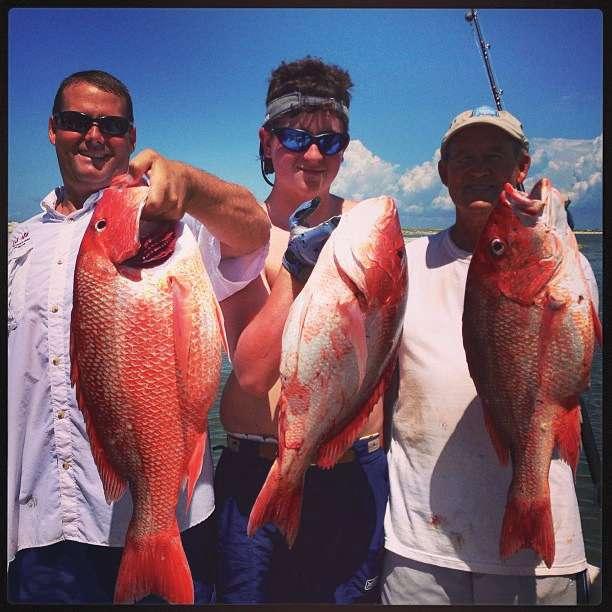
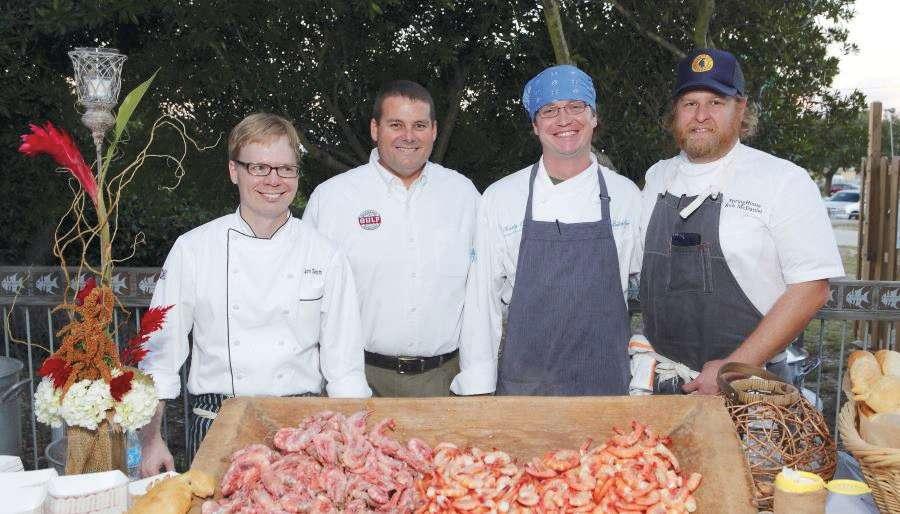
Promoting Alabama Gulf Seafood—hard but tasty work. Photo: ASMC.
long-term trends, but it has not been very efective at being used in a short season fshery like red snapper. The Alabama Marine Resources Division plans to implement an additional data collection system for red snapper in 2014. This new system will allow us to capture a truer picture of what is being harvested and landed recreationally in Alabama. It will be more labor intensive and will cost us money that is already is short supply, but getting the correct information is vital. It means too much to our citizens and our fshery. We must have the best, most accurate information to manage this fshery to its full potential.
Not only do we need better catch data, we need better stock data from the artifcial reefs and other fshery independent data to feed into the stock assessment. The more data we can collect about the relative abundance of red snapper and the age composition in the entire Gulf, the more accurate the stock assessment will be. We have a ways to go to have the information to best manage the red snapper fshery. All the Gulf states and the National Marine Fisheries Service are working to improve the data collection and stock assessments to get the information to manage this world-class fshery.
CA: Increasing fshing
opportunities is great for anglers (we love to fsh) and it’s good for the economy, but how can the state allow more fshing without jeopardizing sustainability?
CB: It is defnitely a balancing act. We create habitat to increase fsh production and fshing opportunities, but at the same time, we want to make sure our fsh stocks are healthy. As the United States’s population increases, so do the number of fshermen. In Alabama, we strive to provide access to the fsheries, while at the same time managing them sustainably for the future. We monitor the catch of what is landed in Alabama both commercially and recreationally. We have a Fisheries Assessment and Monitoring Program that has been efect for over 35 years. This program shows trends in juvenile abundance of fsh, shrimp, crabs and oysters. We also do age composition studies on a continuing basis to see changes in the fsheries. We do all this, as well as other research, to ensure that we are managing our fsheries for long-term sustainability. When we see a fsh stock is declining, we take precautionary measures to be proactive in our management. For instance, after looking at trends in the sheepshead fshery, we noticed a slight change that caused us to take some action. We instituted a minimum size and bag limit to ensure that this fsh was not over-exploited. The sheepshead stock is not in trouble, but with the increased pressure on this species, due to restrictive seasons on other fsh species, we felt it was prudent to take action before it was in crisis.
CA: Fishermen are hearing
more about invasive species, such as tiger shrimp and lionfsh. What has the impact been to Alabama waters and how is the state responding?
CB: In Alabama, we are monitoring the presence of both tiger shrimp and lionfsh. We have only seen a few dozen tiger shrimp over the last several years, but the lionfsh population is exploding. We do not know the long-term efects, but I will say that lionfsh can really eat a lot of small fsh on the reefs. We are concerned. Alabama Marine Resources has been working with local dive shops to increase awareness of the presence of lionfsh and to encourage divers to harvest any lionfsh they see. We also have a task force of divers from both our fsheries and enforcement sections that are making dives to track the abundance of lionfsh on our reefs. While on these dives, the team also removes any lionfsh they see. The dives are funded under a grant program and the funds have been exhausted. We are now seeking funding to expand the program. The key is getting the public involved. In order to help motivate the public to harvest lionfsh, we have partnered with local chefs to cook lionfsh and show how tasty they are when prepared correctly. We have one chef in particular, Chris Sherrill, who is a master at preparing these dangerous, but tasty, creatures.
CA: What’s the one thing
you wish recreational anglers understood or better put into practice when they’re on the water?
CB: Catch and release fshing. I love to eat fsh, and I keep some when I go, but it is not necessary to fll up the box every time you go out. Big bull reds are not that great to eat, but they produce a lot of eggs—so do big trout. It would be great for the fshery if more people enjoyed the experience of fshing while at the same time letting a few go back. Like I mentioned earlier, my son and I caught over 70 kings—we kept two that swallowed the hook. The catching and spending time outside with my son was the great part.
The second thing I wish people did more of is to take their kids fshing. It is so important to get those kids out on the water and replace the game controller or cell phone in their hand with a rod and reel. That time with them cannot be replaced. It will also teach them a skill that will help them in life. I have three teens. They can drive me crazy, but when we are fshing together, all seems well with the world.
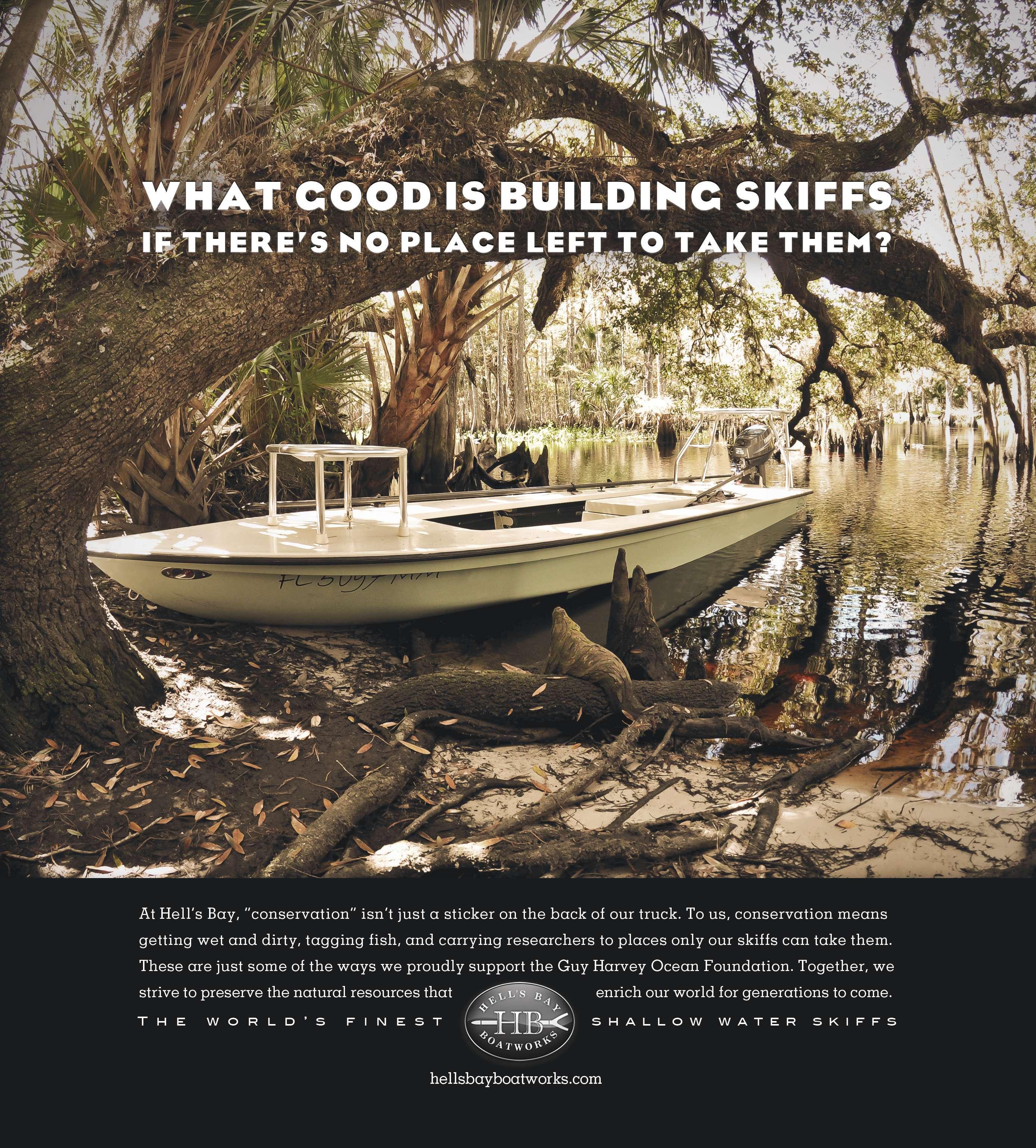
Fly a Kite to Fool the Fish
BY JEFF DENNIS GHM INSIDER
From offshore to inshore, kite fshing techniques can put bait away from the boat and closer to skittish prey.
G E A R H E A D S:
Both casual anglers and toughened tournament types know that fying a kite can be an effective way to draw a strike. Kite fshing allows the bait to be further behind or out to the side of the boat, which cranks up the stealth factor in your bait presentation and can give anglers a real edge in catching wary fsh. Sails, tuna and even redfsh have long been taking baits under kites for those anglers who have these tricks in their tackle box.
Kite fshing is generally used for live baits, so the bait must be kept on the water’s surface or near the top of the water column. If it is out of the water too much, then, obviously, the live bait will die. The technique is similar to a trolley rig used when targeting kingfsh from a pier. The rig positions the bait high, keeping it under the watchful eye of the angler. If a shark approaches, it’s easy to snatch the bait out of the water for a moment.
Of course, while trolling for sails or tuna, one might not be able to view their bait, but kite fshermen have that all fgured out. They attach a weighted foat to their fshing line above the water, using the same variety that is popular for inshore trout fshing. This is known as the foat set, and ofshore anglers will watch for its tell tale signs. If the foat begins circling or bobbing up and down in the air, then it’s very likely that something is after the bait.
Bait rigging is important, too. A blue runner or goggle eye needs to be swimming true in order to draw a strike, so consider using a bridle rig on kite baits. This allows the fshing line to attach to the top of the bait, rather than in the mouth area. Typically, attached to a 7-0’ circle hook is a leader of 60-lb. test that is 15 to 20 feet in length. That leader attaches to a swivel that connects to your fshing line. Above that swivel comes the kite rigging, which includes an egg sinker, the inverted foat set and a ceramic ring. The kite fshing reel is generally spooled with 20-lb. mono line, which ofers less
Kite fshing gear has evolved to give anglers great options for bait presentation in almost any type of weather. Photo: Jef Dennis.
wind resistance than thicker lines. A pro tip would be to run a double-line where the egg sinker slides. Braided line is stronger, but if it comes into contact with any mono lines that are being fshed, there’s a danger that the braid will cut the mono.
One kite reel can fsh up to three kites by rigging three diferent sized barrel swivels onto your spool about 50 yards apart. Rig three kite clips onto your fshing line and the magic happens when the smaller barrel swivels slide though the corresponding holes on the kite clips. Running your lines through these clips keeps your lines spaced apart evenly. To steer each airborne kite, simply attach weight to the side of the kite in the direction that you want it to fy.
A standard kite for the average angler is designed to fy in light winds from 5 to 15 mph. Think it can get too windy to kite fsh? Nonsense. Specialty kites exist for gustier days, and they are designed to have lower line tensions and maintain position with few adjustments. These specialty kites have holes in them that let the wind pass through, and the number and size of the holes correspond with the heavy wind conditions.
What if there is no wind? Kite fshermen have devised a plan for fat, calm conditions, too, by employing a helium balloon to get their baits in position. In all kite fshing, the speed of the boat plays a role, and in many cases, the use of a sea anchor keeps the ultra slow pace that goes well with kite fshing. When using a chum slick and a sea anchor, a kite fshing rig allows one to position baits closer to the end of your scent trail where newly arriving fsh are coming in hot and hungry for action.
Kite fshing for sailfsh in Florida is very popular and occurs all year long. In the Carolinas, anglers treasure the kite for its ability to fsh a bait way back so that wary tuna will be in their mixed bag. Some die-hard kite anglers have even fgured out that a kite is the best way to reach redfsh in winter that are otherwise holding tight in skinny and clear waters in order to warm up. Dangling bait from a kite can be both accurate and sneaky at the same time, which is the kind of tactic that helps smart anglers stay successful.
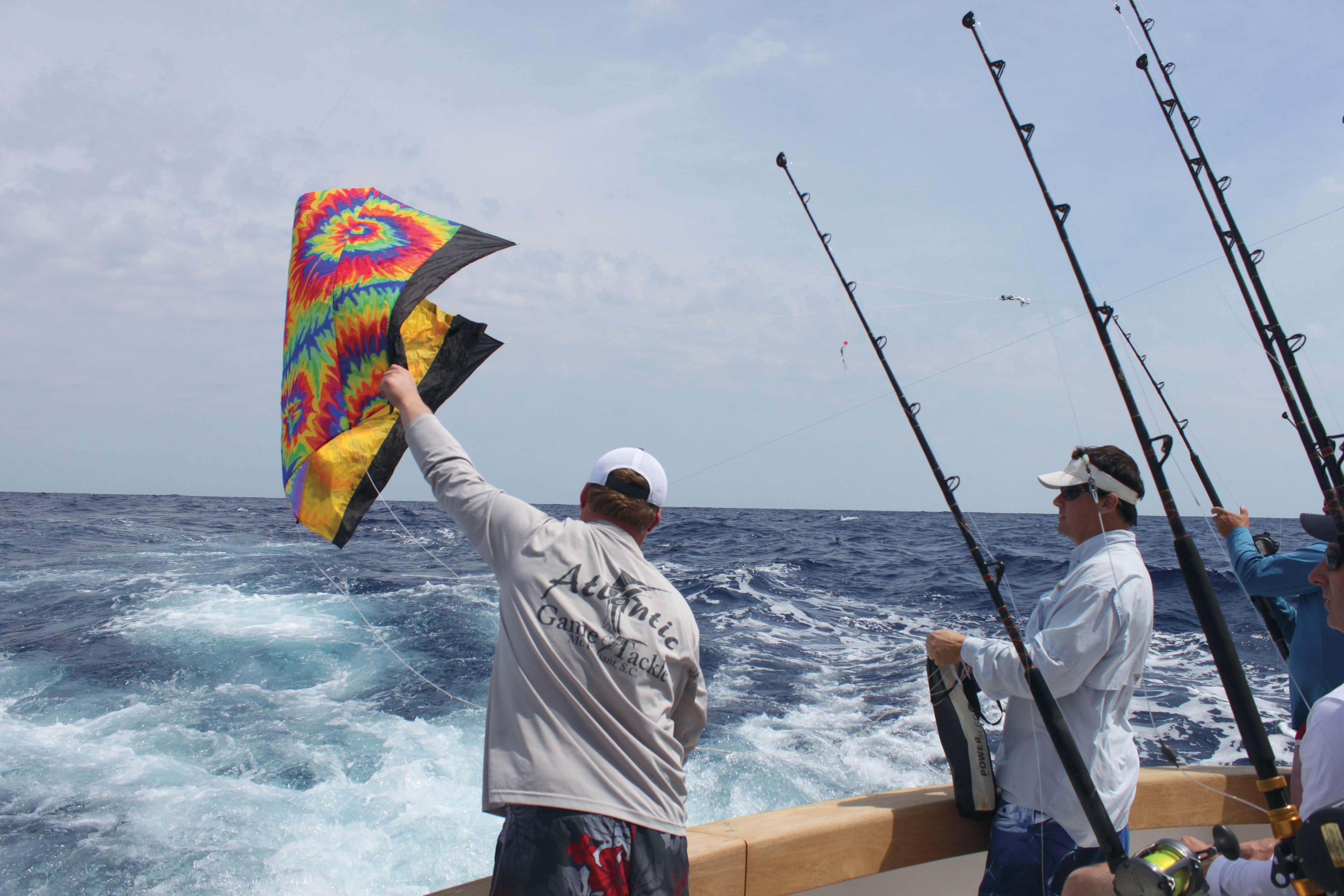
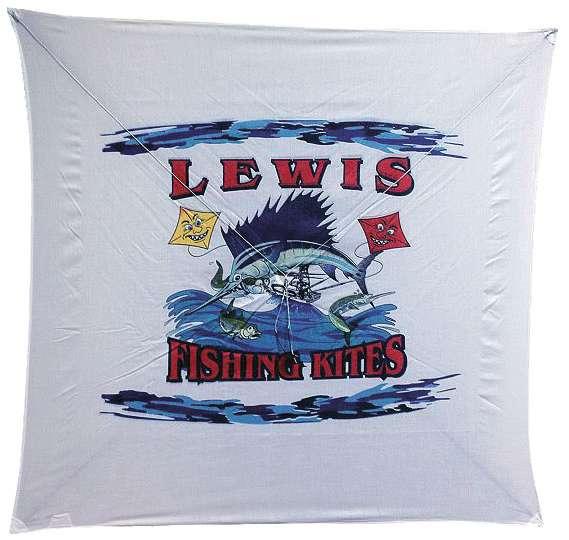


Bob Lewis
Bob Lewis Kites come in four colors and are available for various wind speeds from extra light, light, medium, heavy and extra heavy. The Gale Force Wind kite is for die-hard fshermen or tournament days when the wind is blowing 30 mph or more. The extra strong struts and eight holes help digest the wind and keep the bait in the target zone on the water’s surface. www.LewisSportFishing.com.
Frenzy Fishing
Frenzy Fishing Kites have a high-visibility, quick-dry fabric that is well known on the tournament trail. The carbon fber spars are easy to work with as you insert the struts, and the adjustable bridle provides a quick setup. It comes in a crush-proof plastic tube, which provides for convenient storage and travel. www.FrenzyTackle.com.
AFTCO
Aftco Kites are becoming more popular as the familiar tackle brand keeps producing quality gear. This kite is constructed of waterproof, rip-stop nylon sailcloth that fies great when wet and resists mildew when stored. Interchangeable spars allow adjustment for any variable in wind speeds. www.Aftco.com.
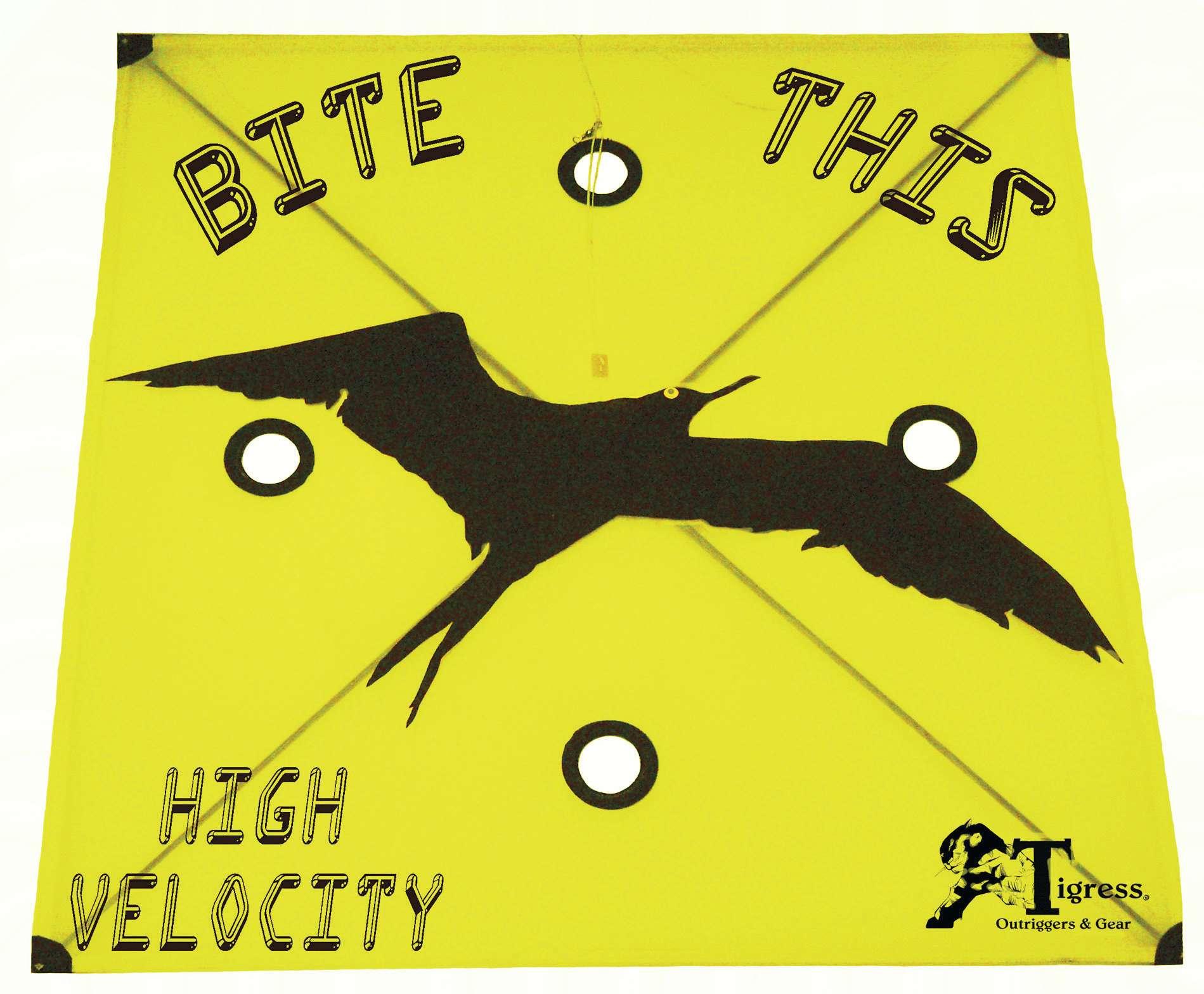
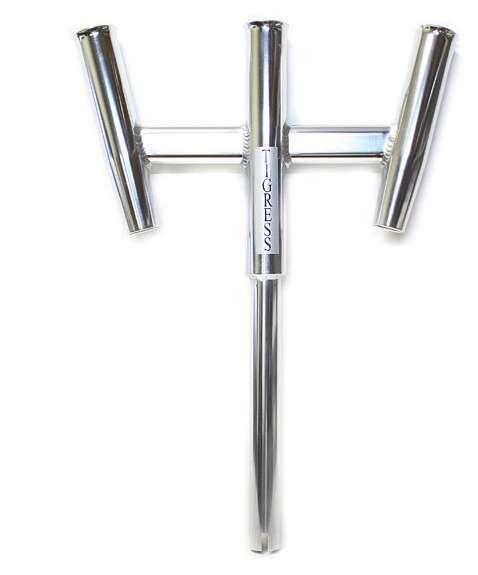
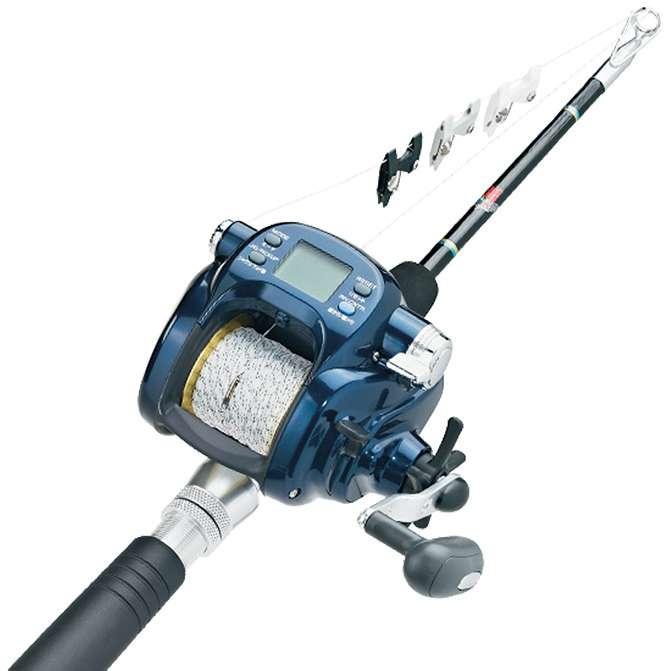
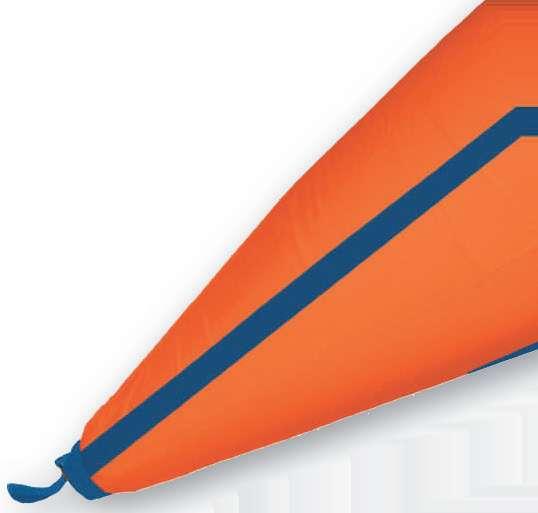

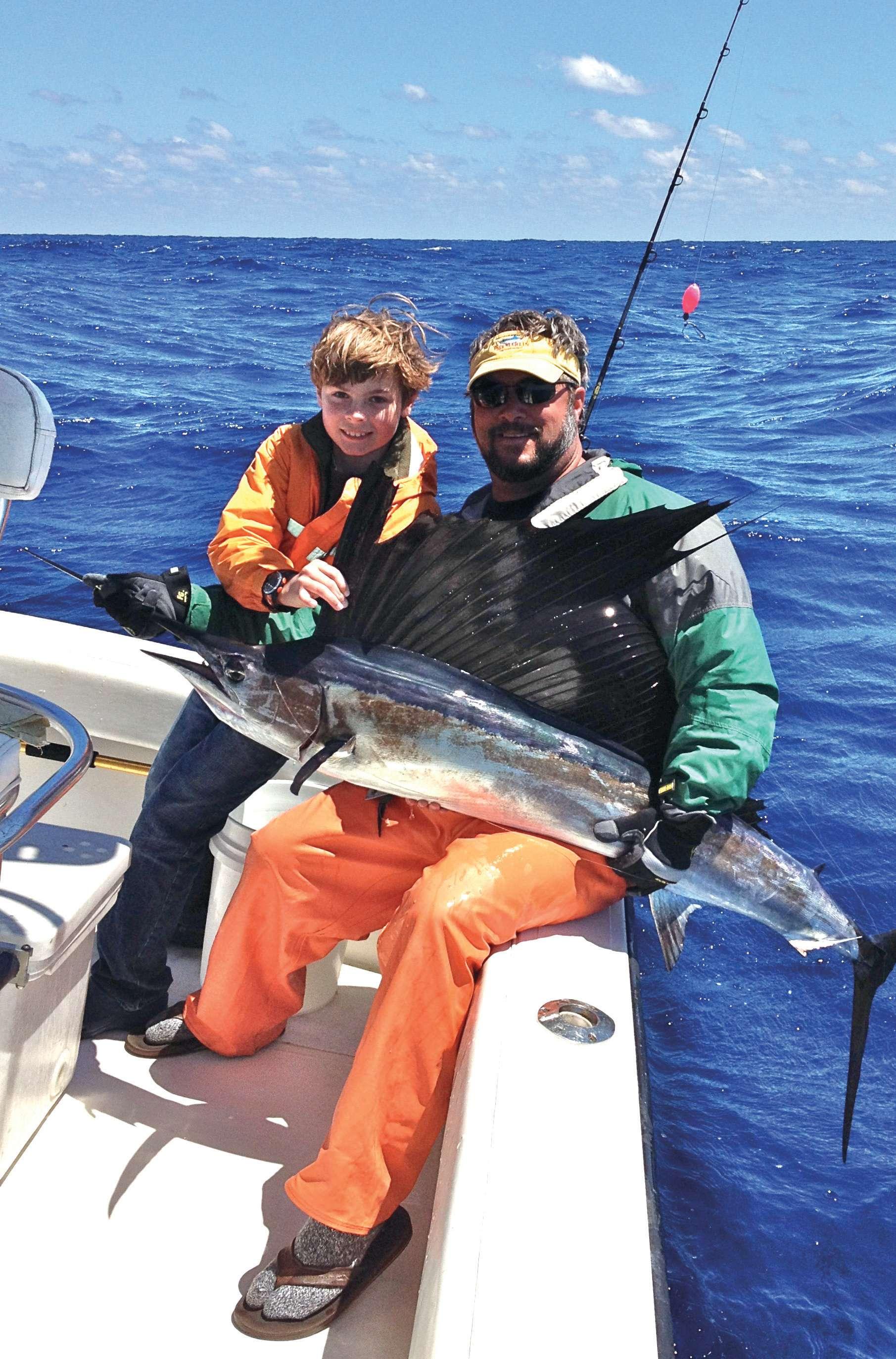
Tigress
The Tigress Hi-Performance Bite ofers 100% carbon graphite spars that are both durable and ultra-lightweight. Also available from Tigress is a full line of kite clips, ceramic rings and triple rod holders. www.TigressOutriggers.com.
Daiwa
Daiwa Dendoh Tanacom Bull reels ofer what anglers need for kite fshing. The reel delivers plenty of power to reel in the kite while you worry about fghting the fsh. The winding arm is redundant, but a “necessary luxury” since no one wants to hand-line a kite back to the boat. A digital readout keeps track of how much line is out. www.Daiwa.com.
Eval
A sea anchor can help to steady the drift of the boat during kite fshing, and the Eval anchor is made of reinforced PVC fabric and has tough nylon belts. www.NauticeExpo.com. Kite fshing is a classic strategy for skittish sailfsh. Photo: Jef Dennis.

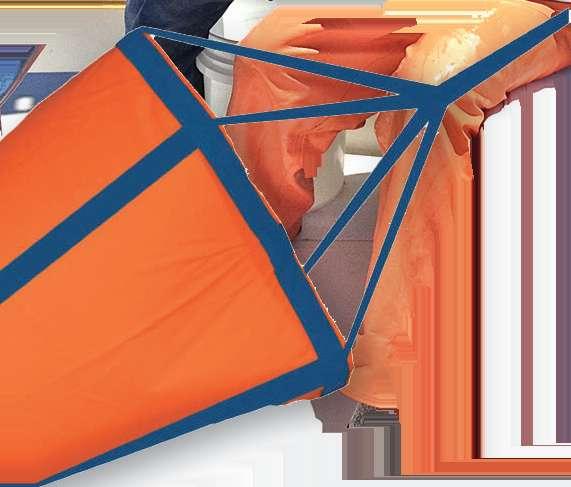
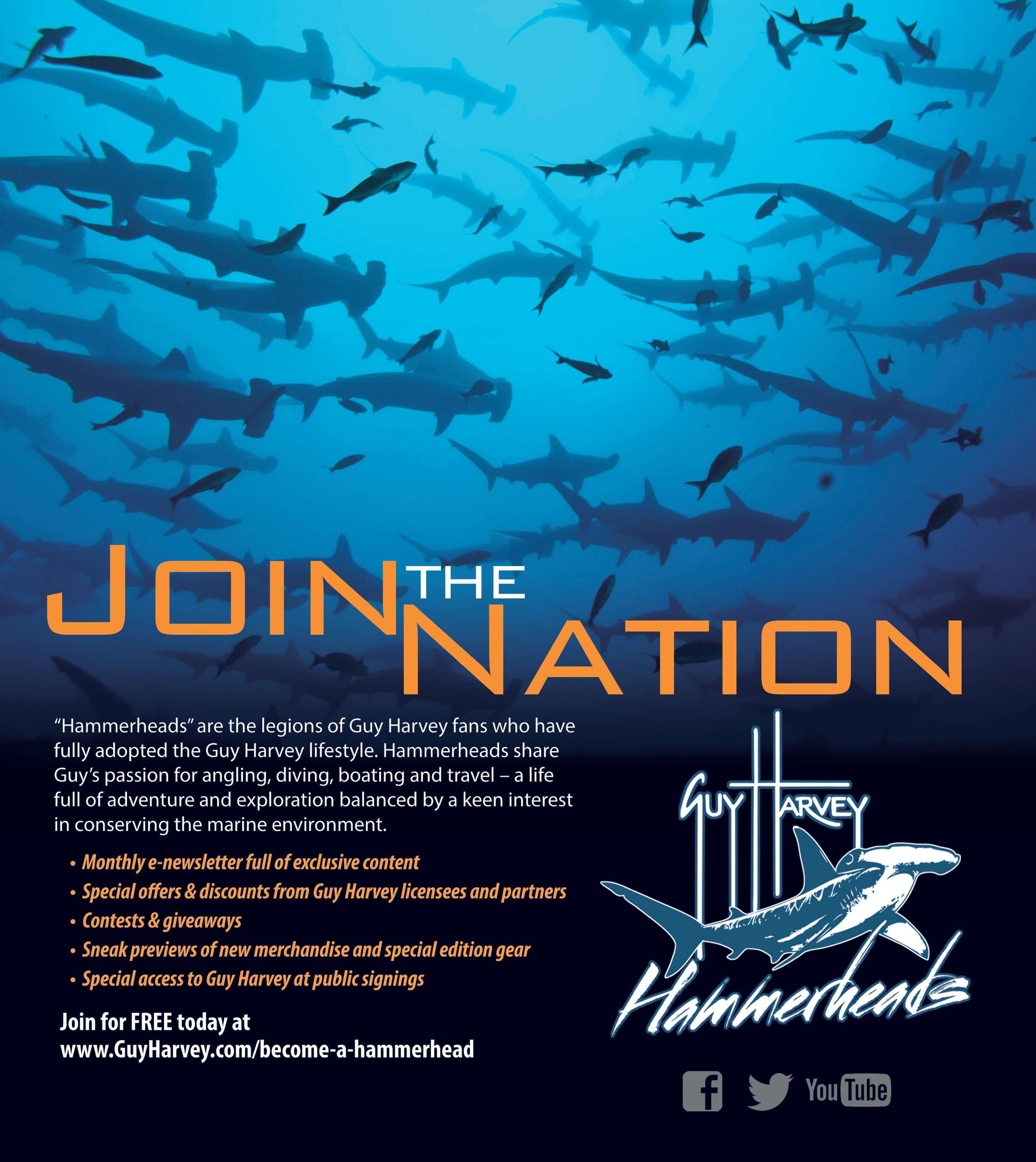
Ozzy Delgado, left, with Captain Antonio “Chombo” Isaza and mate Maicol Rios celebrate with a beautiful Pacifc blue marlin—a frst for Delgado.

Panama, the skinny strip of land where the Americas meet, is known for its bustling economy, awesome natural wonders, international banking and a great salsa singer named Ruben Blades. Oh, and there’s a canal or something, too. But among fshermen, Panama is best known for monster yellowfn tuna, hoss cubera snapper, roosterfsh, and enough blue and black marlin that you sometimes have to use a stick to beat them back from jumping in the boat. It’s the latter that excites me about a recent invitation to the Panama Big Game Fishing Club.
Our cover story for getting in is that we will be flming a TV show with Captain Diego Toiran, who hosts the Spanish-language fshing series Pescado en los Cayos. My job is to cover the expedition for GHM. We do both (you’re reading this, aren’t you?), but I am just geeked about going to a place known for having an obscene number of record-breaking fsh. Some linguists have doubts, but most Panamanians agree that the word “Panama” actually means “abundance of fsh.” It’s their country, so I fgure they can defne it however they want. And after our experience, I’m a believer.
Our trip begins with the fight into Panama City (the capital city) where everyone with a window seat gets a good look at the ships waiting to go through the canal. I admit it is pretty cool. I wonder if there are some monster snook in there. Maybe that’s another TV show. As we exit the plane, we get our frst taste of the “VIP” travel treatment being provided by our new friends at PBGFC. “Welcome to Panama,” says a dude holding an iPad with our names on it. He leads us through the airport to a VIP lounge where we hang out to wait our turn with customs. Once that’s done, we’re of in a limo to the Veneto Hotel & Casino where we stay the night before catching an in-country fight and heading to the Club itself.
The Veneto is a Wyndham Grand Hotel. It’s in Panama City’s business and fnancial district and ofers all the modern amenities that high-rolling travellers
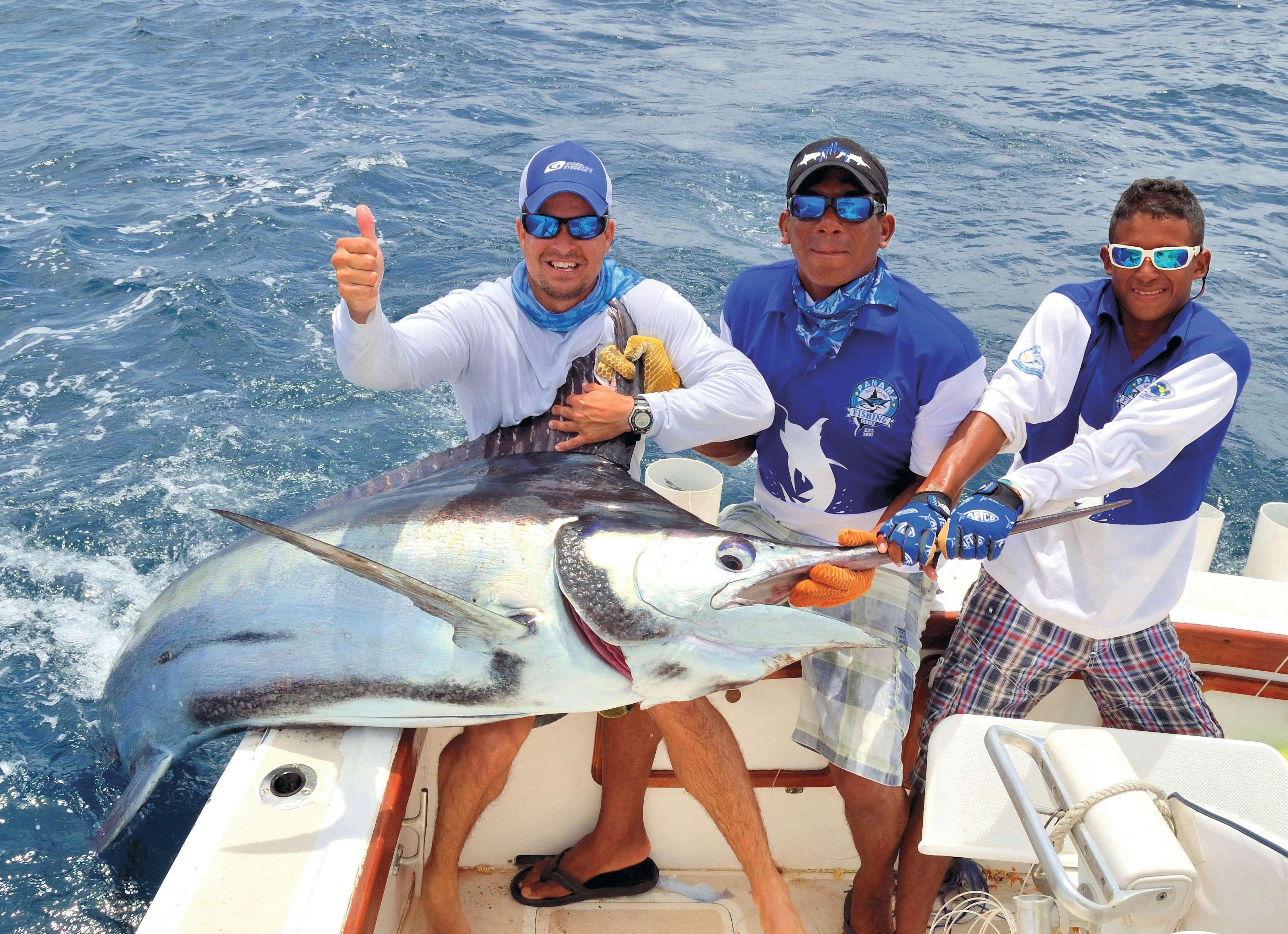
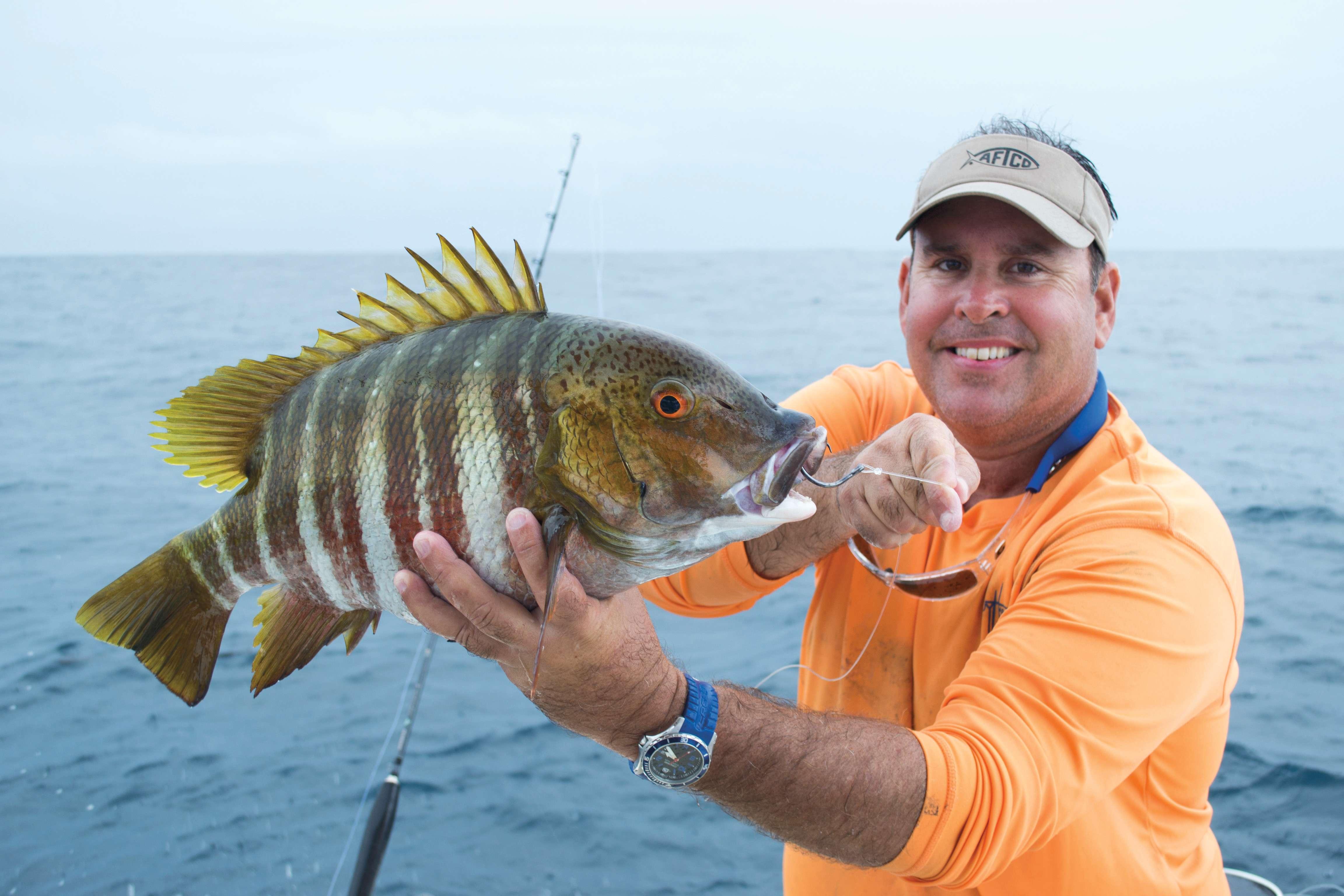
expect—a spa, sauna, ftness center, a Vegas-style casino and some seriously good eats. Their New York Steakhouse restaurant gets my vote, but there’s a top-notch sushi lounge, too. The Veneto caters to fshermen traveling in and out of the country, and their chef will even cook your catch.
Our fight the next day is an afternoon departure, so our host, Ms. Corcio, arranges a quick tour of Panama City. Our frst stop is Mercado De Mariscos (Panama City Fish Market), a swanky joint where we sample some awesome ceviche, a national favorite. Our tour also includes a stop at the Panama Canal. It’s a major tourist attraction and well worth a visit if you’ve never been. This engineering marvel accounts for a huge chunk of Panama’s annual GDP. Some call it the “the eighth wonder of the world.”
We wrap up the sightseeing and catch the fight from Panama Top: Captain Diego Toiran with a Pacifc rock snapper. Below: Delgado shows of a monster cubera City to David, a quick 35-minute hop to the west end of the country. snapper. This species has made a comeback since local captains agreed to protect it through catch Victor Archbold, general manager of PBGFC, is there to pick us up. and release fshing. So far, the trip has been pleasant, but we’ve been in the country for 24 hours and I haven’t wet a line yet. I am starting to get the sweats. I ask Victor about the bite.
“Ozzy, it’s been slow all week,” he says. I can feel panic starting to creep in, but I push it back. We are in Panama, after all, and I decide to keep a positive vibe and just enjoy things as they came. Forty-fve minutes later, we arrive in Boca Chica where we board a boat to cross the river to the club. It’s dark now, but getting on the boat makes it feel like we’re fnally in fshing paradise. And whatever qualms I had about the poor fshing report are being soothed by the sheer luxury of the resort. Within 15 minutes of hitting the dock, we enjoy our frst beverage, toast a great week to come, and are ushered to a fve-star dinner. It also doesn’t hurt that the dining room is decorated wall to wall with pictures of past catches, trophysize mounts and a big-screen TV playing videos of guests battling monster fsh. Jose Acosta, our cameraman and the third member of our team, looks at me over dinner and says, “Ozzy, everything is going to be fne.” I drift of to sleep that night hoping for the best.
Fishing happens early at the Club. Our wake-up call is at 5:30 a.m., but the staf is kind enough to supply lots of cofee. “Gentlemen, you will marlin and giant yellowfn. We load up on bait and then make our run to Isla be fshing with Chombo today.” This is good news. Fishing with one of Panama’s Montuosa in the Gulf of Chiriquí. It’s about 60 miles from the coast and sits just of best captains holds a lot of promise for the day. The Club’s fshing feet consists of the famous Hannibal Bank. Even before we get too close to the island, the fshing Carolina Classics and Bertram sportfshing boats, and they are armed to the teeth turns on. We see humpback whales breaching and porpoises are all over us—pods with that number in the hundreds. I feel like I’m in a Discovery Channel special. Ever the top-of-the-line gear—no need to bring your own tackle. After breakfast, we vigilant captain, Chombo snaps us back into reality and tells us to get ready for fnally hit the water. some action.
A typical day here starts with catching live bonito, which are like candy for We run to the front of the porpoise pods and cast in some live bait. Bam! We

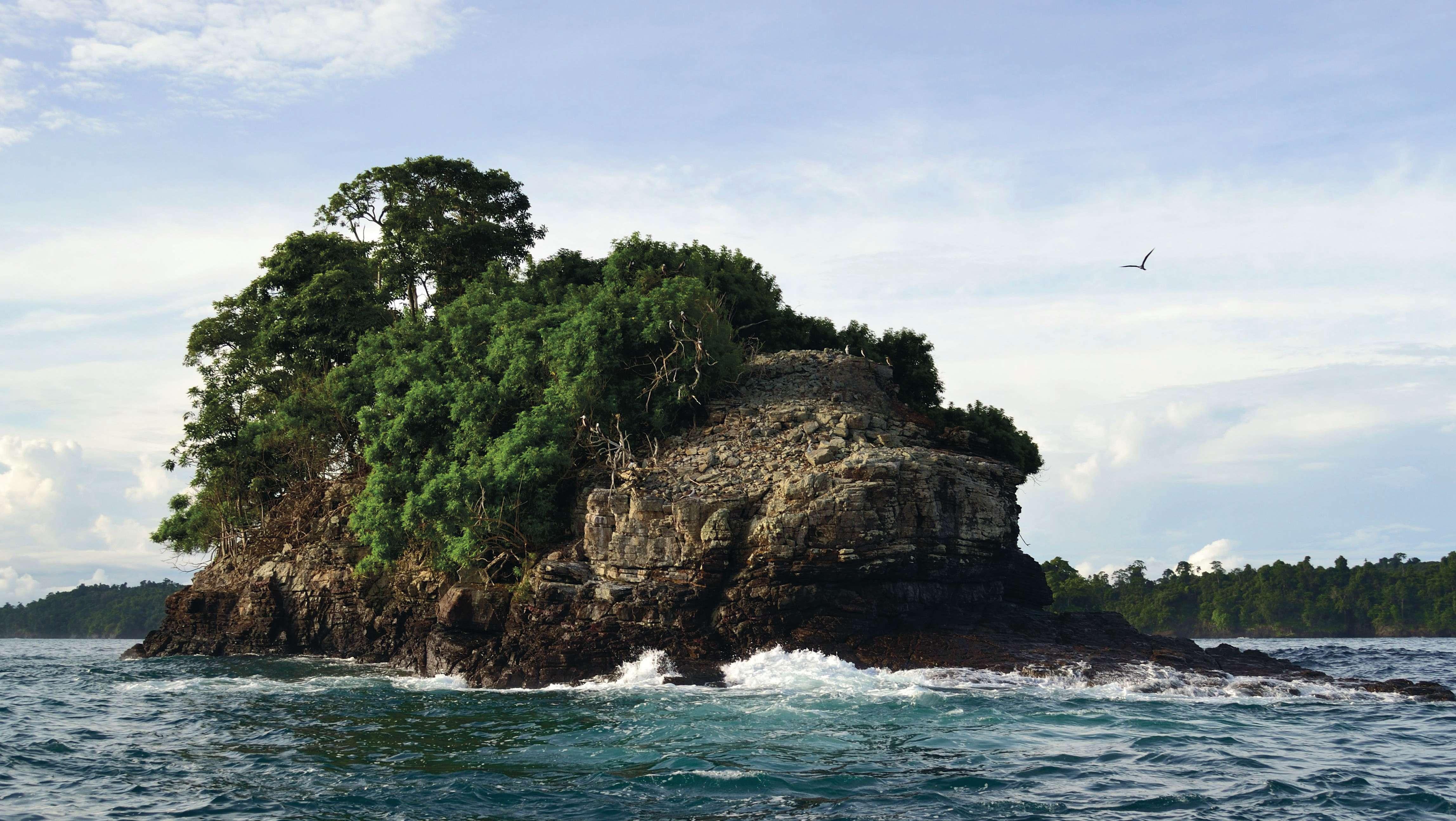
These beautiful volcanic islands host the most vibrant marine habitats in the Pacifc Ocean.
hook up instantly. Diego’s reel starts screaming, and so does mine. We soon gaf a nice pair of tunas in the 40–60 lb. range and then hit the throttle to reposition for round two. We run with the porpoises and at the right time, pitch the bait in front of them again. We catch more fsh and the pace is sometimes frantic. All the commotion starts to attract some other boats to the area, but it isn’t a problem. We have a great crew that keeps us on the fsh and there are plenty of those to go around. After an amazing day of rod-bending action and sore muscles, it is time to head back to the lodge. The ride in is a great opportunity to chat with Captain Antonio “Chombo” Isaza and our mate, Maicol Rios. Great captains and crews are not always known for being warm and charming, but that is not the case here. The camaraderie on the boat is easy, and more like old friends fshing together.
After an action-packed day on the water (this is slow fshing???), down time for the evening is all about recharging. We lounge around in the infnity pool, snack on passion fruit-infused wahoo ceviche and hang out at the wet bar, watching video footage from the day’s trip on a huge fat-screen. Oh, and the grilled wahoo with pesto dinner, topped with crumbled apple pie and pistachio ice cream sends my taste buds into a frenzy. The Club knows how to entertain.
Our second day on the water, we arrive at the remote Isla Montuosa, and to our liking we are the only boat around. The bad news is there is no surface action as before. Captain Chombo improvises and decides to rig some live bonitos and power-drift them close to the island in search of marlin. We work the baits and wait. Not long after, a shout comes from the helm. “The porpoises are coming!”
We pull in the baits and begin racing with the pods in a repeat of the frst day. As soon as we cast in again, my reel starts screaming. “Ozzy, that one is not a small tuna,” warns Chombo. Anyone who has tangoed with a big tuna knows their incredible power. I fght this one in stand-up gear with a conventional 30-class reel. After close to an hour, we get the fsh alongside and put the gaf in it. I am feeling proud. It’s the largest yellowfn I’ve ever boated. All the tuna we catch are in the 100–120 lb. range, and even the cameraman, Jose, lands his frst big yellowfn.
When you hear about the fshing here, you start to wonder if it’s all true. What makes this place so fertile and full of fsh? The answer is awesome, underwater geography. The Gulf of Panama is a unique environment, fed by the nutrientrich waters of the Humboldt Current, also known as the Peru Current. This large upwelling supports an extraordinary abundance of marine life. Nutrient-rich water creates a strong base for the food chain, starting with microscopic plankton and baitfsh and moving all the way up to the big-boy gamefsh. It’s like a massive, well-stocked aquarium.
After wearing ourselves out on tuna for two days straight, we decide on day three to change things up a little and target some inshore species. Just a short ride
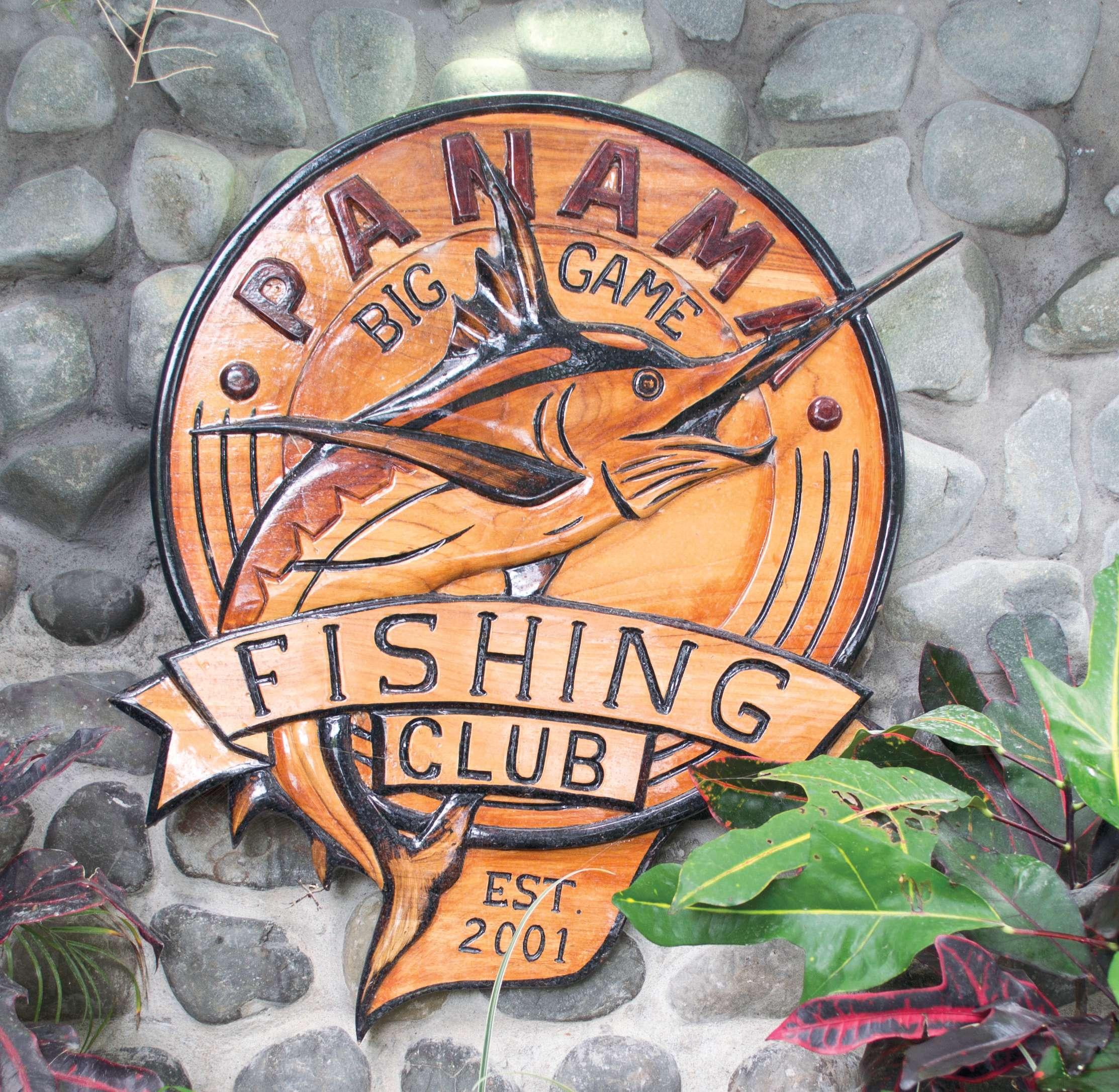
The Club
The Panama Big Game Fishing Club is ideally situated on the country’s southwest coast, and owner Mark Charman is a founding member of the Panama Marine Resource Foundation—a group dedicated to creating a sustainable marine environment in Panama. The Club hosts visitors year-round. The best from the Club lays time to pursue billfsh is from December to April. a string of lush, but Giant yellowfn tuna are most plentiful in the spring. largely uninhabited, That said, the best time to fsh Panama is simply islands. As we whenever you can, as the bite is always on. Guests are approach, I start pampered and accommodations include all the must- replaying scenes haves of modern life. Villas include large, fat-screen from the Jurassic Smart TVs, Wi-Fi service, cofeemakers, a mini bar and Park movies in my much more. Dining is a fve-star culinary experience, mind. “Islas Secas!” and the staf ofers warm, personal service. For its shouts Chombo. combination of red-hot fshing, strong conservation We slow-drift a ethic and outstanding service, the Panama Big Game pair of live baits just Fishing Club has earned the Guy Harvey Magazine’s 15–20 yards from Editor’s Choice Award for #1 Boutique Fishing Resort the island. I ask what in Central America. species of fsh roam these waters. I’m shocked to hear that not only roosterfsh, but Cubera snapper are prevalent. Mahi, wahoo and other gamefsh come in very close to shore, too. “You could be 10 yards from the rocks and the depth could be 40 feet and then move another 10 yards and down you go to 100-plus feet,” explains Maicol, our mate.
Not long after we arrive, Chombo shouts, “Fish on!” It’s a roosterfsh and it’s reeled in by my friend Diego. Ten minutes later my reel gets a hit, but my roosterfsh spits the hook. Captain Chombo takes us to another place and Maicol hands me a spinner with a top-water popper. “Cast around that rock protruding out of the water,” he says. I hook up and this fght turns into an awkward ballet. I’ve got a giant Cubera snapper hanging on my line, wanting to run into the rocks. The captain keeps repositioning the boat to help keep the fsh clear. It is coordinated chaos, but we land the fsh. Chombo estimates its weight at 40–45 lbs. before we release it back into the water. “Captains in all the resorts got together and made a decision to release all Cubera snapper,” he tells me. “We need to protect the ecosystem and this fsh is vulnerable.”
With three days of non-stop action, it’s turning out to be the fshing trip of a lifetime—11 diferent species and the sore muscles to go with it. That night, getting ready for dinner, I sit down with Captain Chombo to discuss the plan for the next day. “We are going to concentrate on your marlin,” he tells me. “Forget about any other species; let’s go after your fsh.” He sounds confdent and it’s contagious.
In the morning, we head out to the acclaimed Hannibal Bank. It’s known for spectacular marlin fshing with many blacks and blues caught here each year. The most productive tactic is bridling live bonitos, though trolling is also a solid option. The bank sits along the edge of the Pacifc continental shelf and goes from a depth of 120 feet to more than 3,000 feet within a span of just three miles. With tuna tubes flled with fresh bonitos, we’re ready for battle. Maicol drops a pair of baits into the depths and within fve minutes, the reel explodes into action. Everyone works to bring in the other lines and I strap into the fghting chair. And just as fast as it starts, it is over. The hook pulls free. “It was a black marlin,” confrms Chombo.
Undeterred, we opt to change to artifcial baits and work the area. Trolling for marlin can be boring, but being surrounded by beautiful landscapes does make it better. Several hours pass with no luck. Everyone is gets lethargic and I start to doze. Suddenly, I hear Maicol shout, “Adelante, adelante!” It’s Spanish for “move forward!”
Before I know it, I’m in the chair again. The rod is bent to the point I think it is going to break. In front of me is an unbelievable sight: a massive, beautiful fsh
